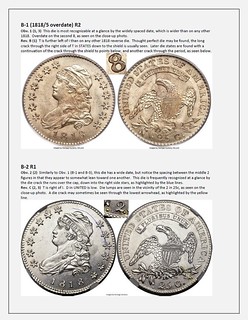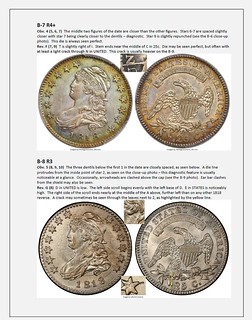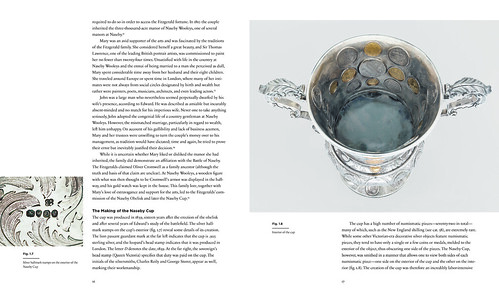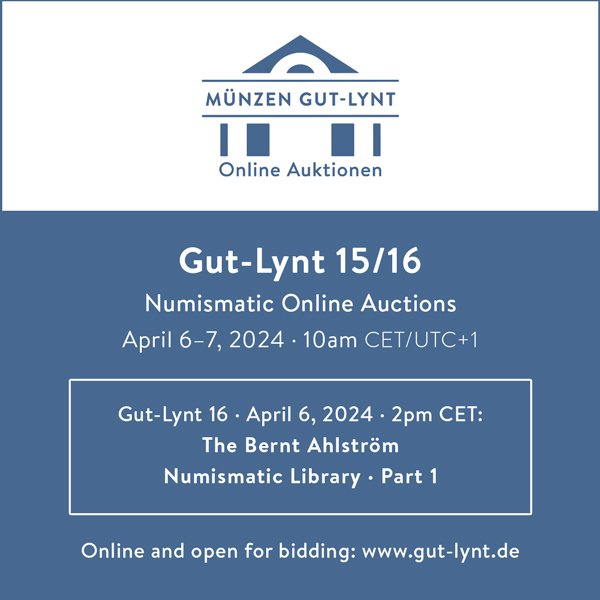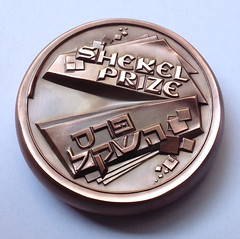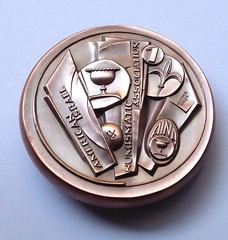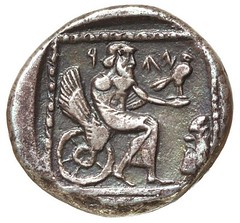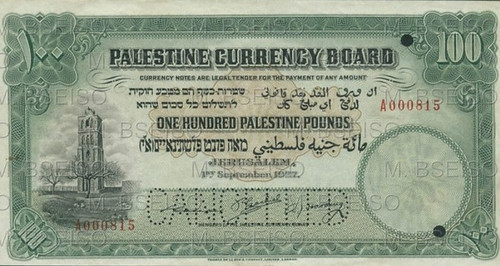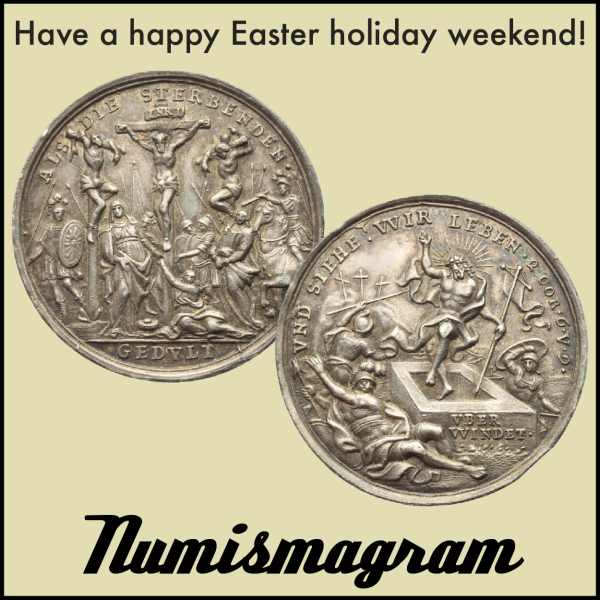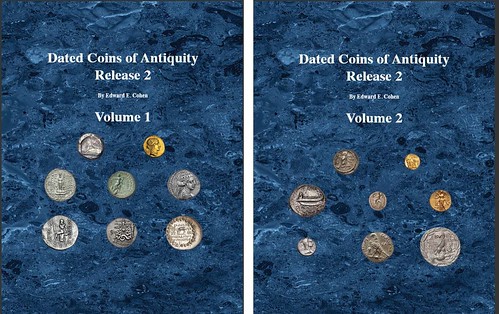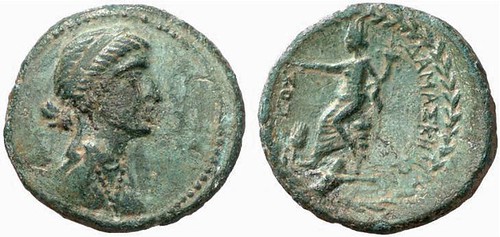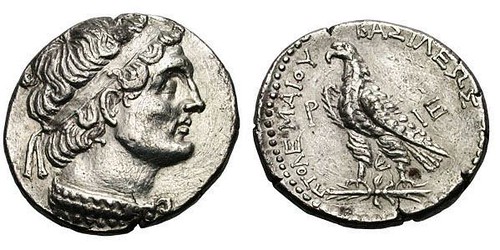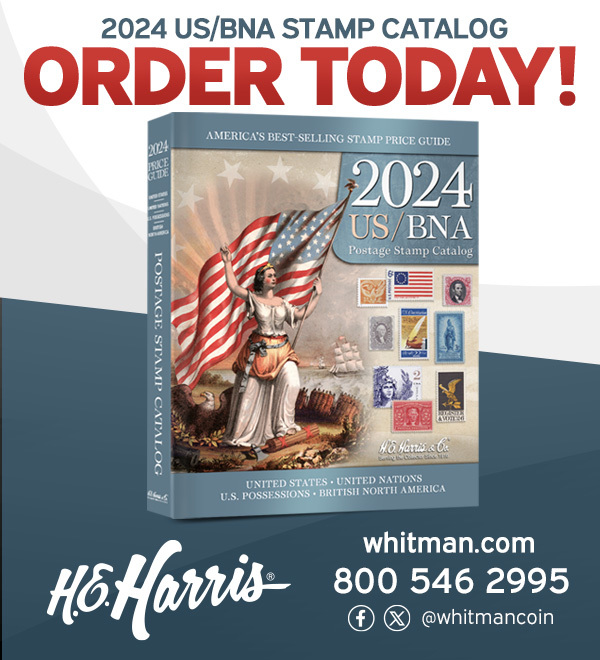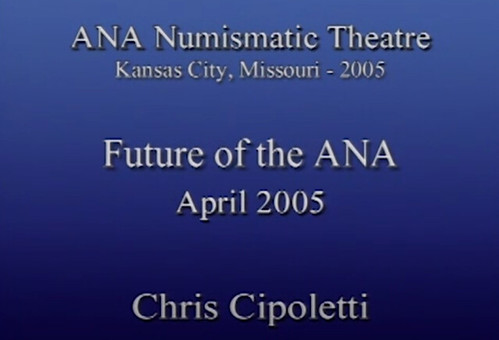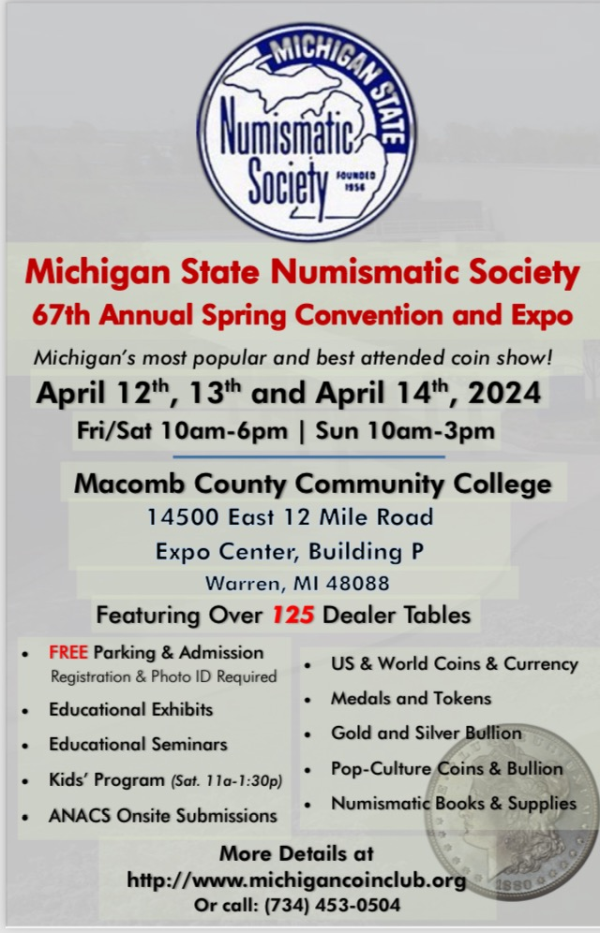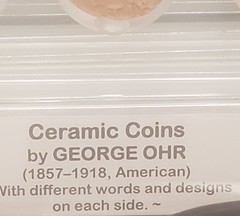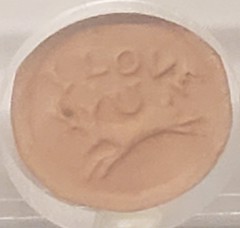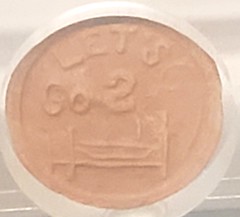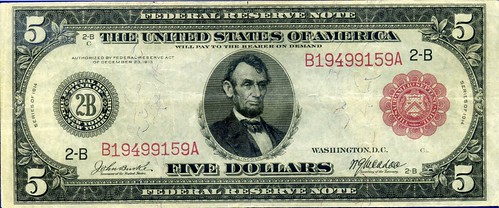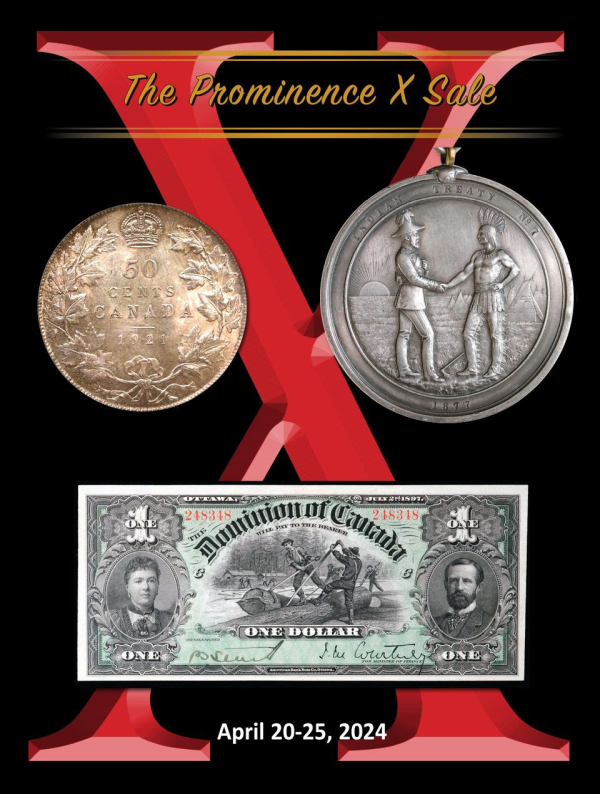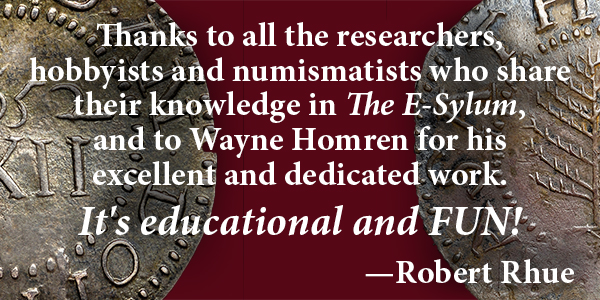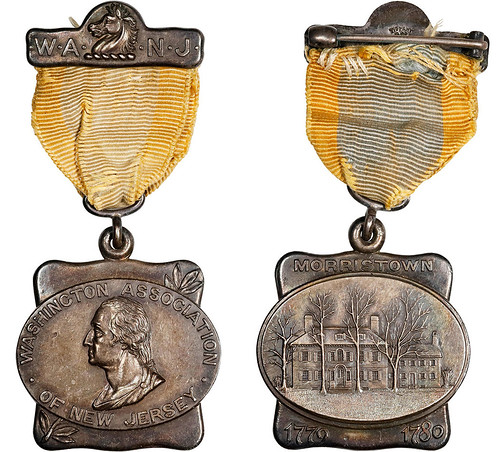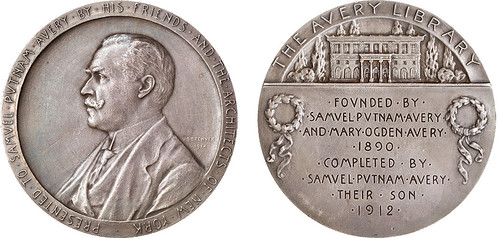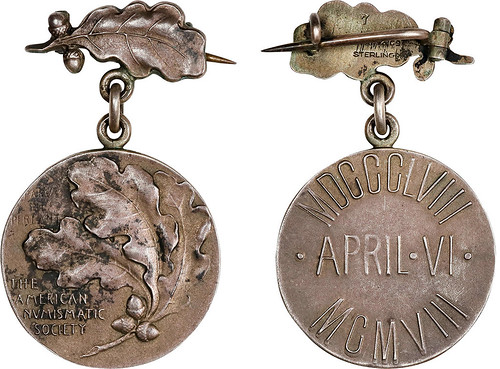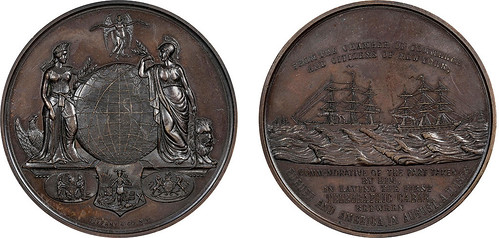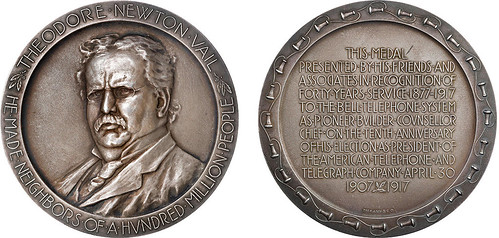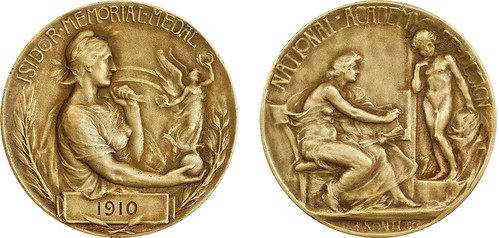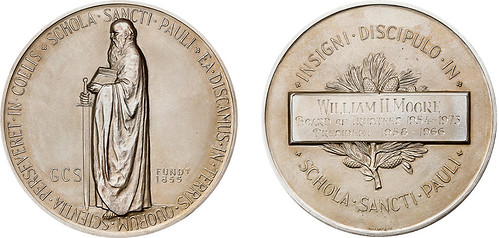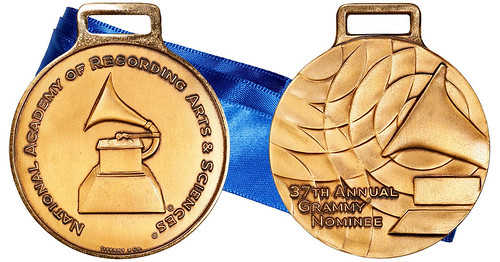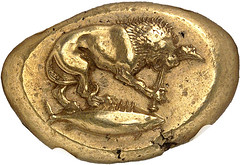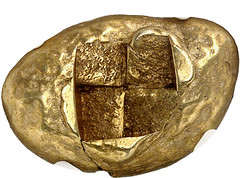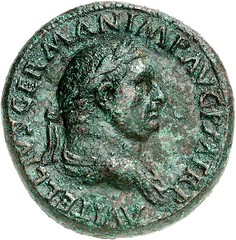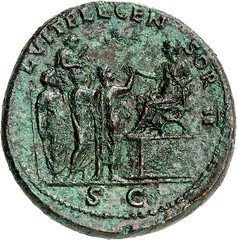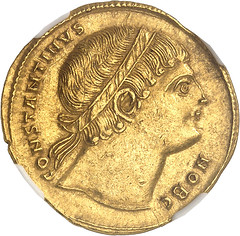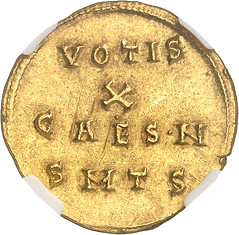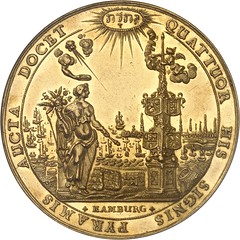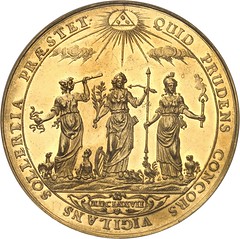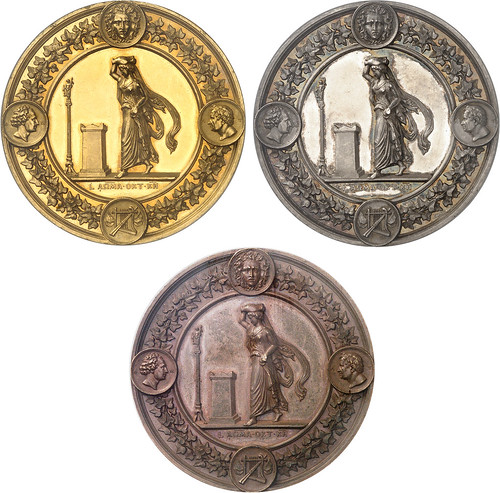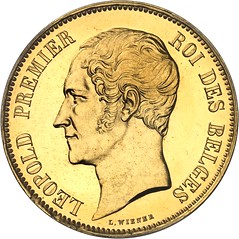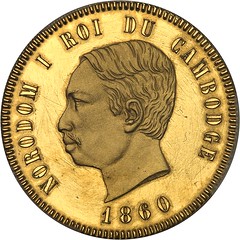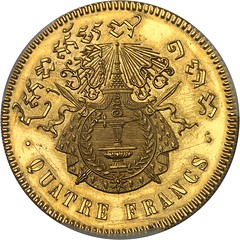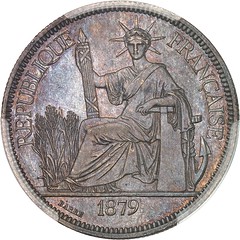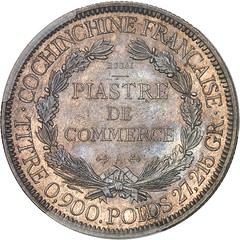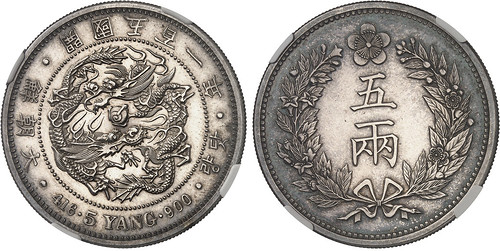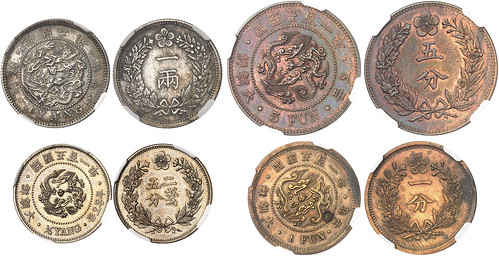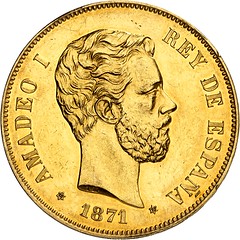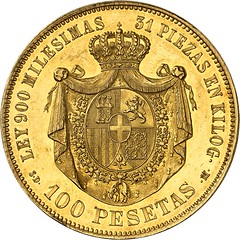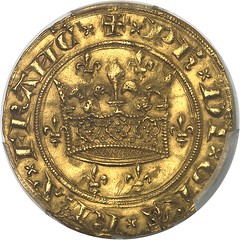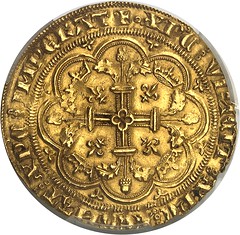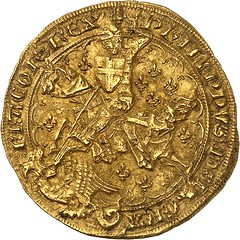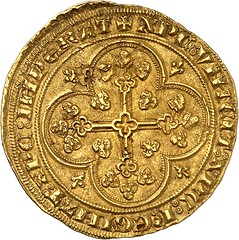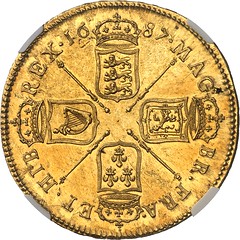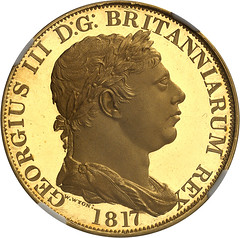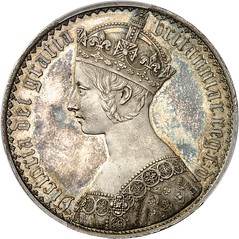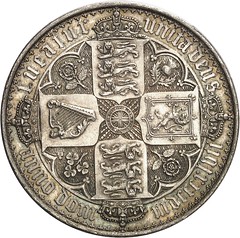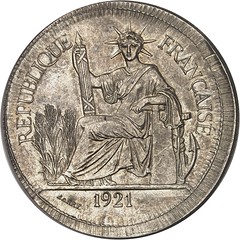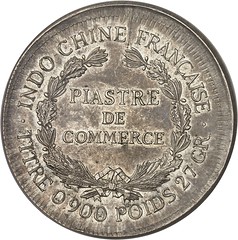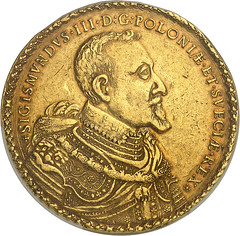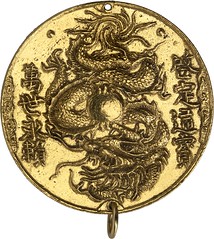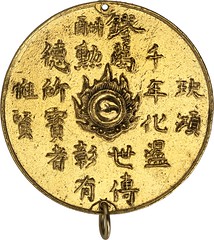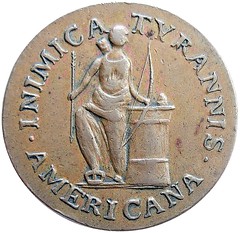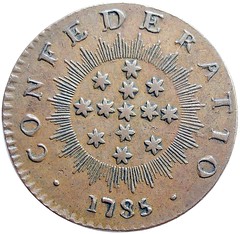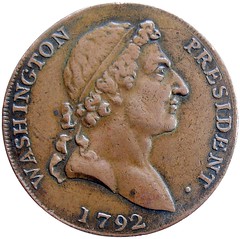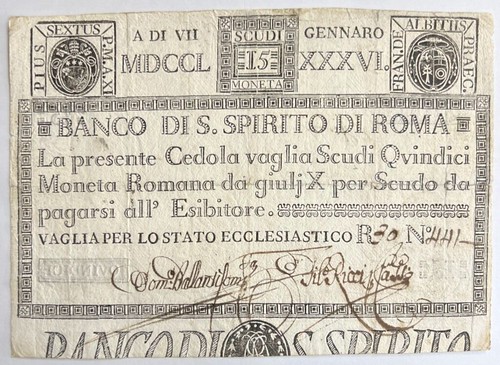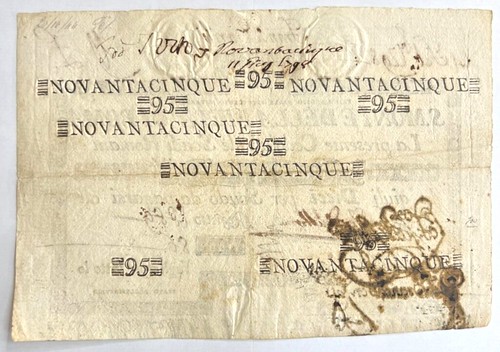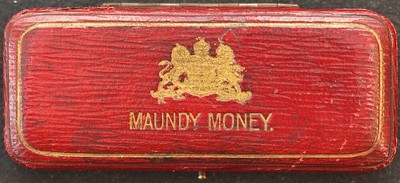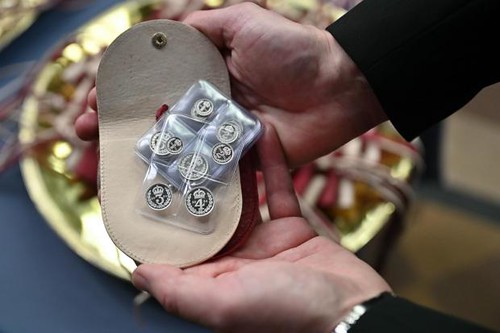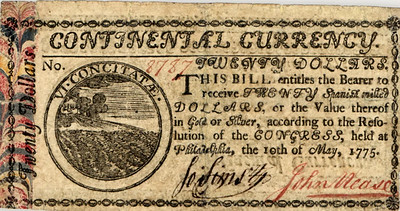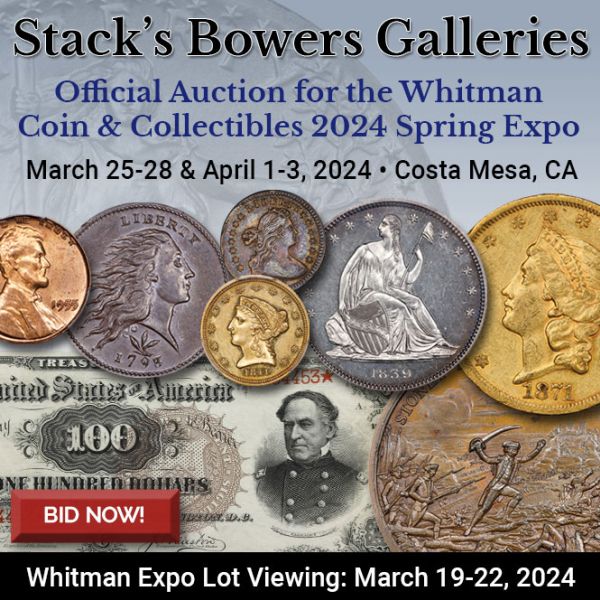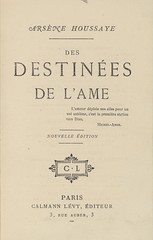
Visit our NBS Sponsors
About UsThe Numismatic Bibliomania Society is a non-profit association devoted to the study and enjoyment of numismatic literature. For more information please see our web site at coinbooks.org SubscriptionsThose wishing to become new E-Sylum subscribers (or wishing to Unsubscribe) can go to the following web page link MembershipThere is a membership application available on the web site Membership Application To join, print the application and return it with your check to the address printed on the application. Print/Digital membership is $40 to addresses in the U.S., and $60 elsewhere. A digital-only membership is available for $25. For those without web access, write to: Jeff Dickerson, Treasurer AsylumFor Asylum mailing address changes and other membership questions, contact Jeff at this email address: treasurer@coinbooks.org SubmissionsTo submit items for publication in The E-Sylum, write to the Editor at this address: whomren@gmail.com BUY THE BOOK BEFORE THE COINSale CalendarWatch here for updates! |
- WAYNE'S WORDS: THE E-SYLUM MARCH 31, 2024
- NEW BOOK: U.S QUARTERS 1796-1838
- NEW BOOK: THE NASEBY CUP
- NEW BOOK: THE YEHUD COINAGE
- 2024 SHEKEL PRIZE ANNOUNCED
- BOOK REVIEW: DATED COINS OF ANTIQUITY, RELEASE 2
- GORDON WELLS BERG (1936-2024)
- AN EASTER EGG HOARD
- 2024 NEWMAN GRANT DEADLINE NEARS
- VIDEO: FUTURE OF THE ANA, APRIL 2005
- WHITMAN BRANDS IS BORN
- NOTES FROM E-SYLUM READERS: MARCH 31, 2024
- SHOEMAKER'S CHANGE-MAKING DILEMMA
-
IMPORTANT
THINGS - MSNS APRIL 2024 EDUCATIONAL PROGRAMS
- PANEL: ISLAMIC COINAGE
- CONFERENCE: FROM SOLIDUS TO STAVRATON
- SYMPOSIUM: MONEY, WAR AND MORE
- VOCABULARY TERM: PHOTOGRAPHY
- A DICK JOHNSON BIOGRAPHY
- DICK JOHNSON COLLECTION SELECTIONS
- MDC MONACO AUCTION 14 HIGHLIGHTS
- WAYNE'S NUMISMATIC DIARY MARCH 31, 2024
- MAUNDY COINAGE THEN AND NOW
- NEVADA STATE MUSEUM'S DATSOLALEE MEDAL
- MARBLED MONEY
- CASHLESS NATIONAL PARKS DEBATE
- LOOSE CHANGE: MARCH 31, 2024
- HARVARD REMOVES BINDING OF HUMAN SKIN
Content presented in The E-Sylum is not necessarily researched or independently fact-checked, and views expressed do not necessarily represent those of the Numismatic Bibliomania Society.
WAYNE'S WORDS: THE E-SYLUM MARCH 31, 2024
 New subscribers this week include:
Jason Elwell of the International Coin Club of El Paso;
Chris Carter, via a Ron Guth YouTube video; and
Michael DeYoanna.
Welcome aboard! We now have 7,297 subscribers.
New subscribers this week include:
Jason Elwell of the International Coin Club of El Paso;
Chris Carter, via a Ron Guth YouTube video; and
Michael DeYoanna.
Welcome aboard! We now have 7,297 subscribers.
Thank you for reading The E-Sylum. If you enjoy it, please send me the email addresses of friends you think may enjoy it as well and I'll send them a subscription. Contact me at whomren@gmail.com anytime regarding your subscription, or questions, comments or suggestions about our content.
This week we open with four new books, the Shekel Prize, one obit, updates from the Newman Numismatic Portal, Whitman Brands, and more.
Other topics this week include new banknote confusion, numismatic educational programs, conferences and symposia, the Dick Johnson collection and other auction highlights, Maundy money, marbled money, and that creepy book bound in human skin.
To learn more about early U.S. quarters, the Naseby Cup, Yehud coinage, Dated Coins of Antiquity, George Ohr's ceramic coins, the Pugilist Sower, slabbed coins, the legendary sneaker featuring printed money, Morse Code on Money, Islamic and Byzantine coinage, the Avery Library medal, a Bolen struck copy, the greatest coin robberies, the Dat So La Lee medal, people portrayed on both sides of the same coin, anthropodermic bibliopegy, and numismatic investment literature, read on. Have a great week, everyone!
Wayne Homren
Editor, The E-Sylum
NEW BOOK: U.S QUARTERS 1796-1838
Robert Powers has published the ninth book in his series of variety & die state attribution guides. -Editor
 Proudly presented to you is the 9th publication of a series of variety identification guides covering Early U.S. Coins. This book covers all of the currently known die marriages of the U.S. Quarters series from 1796-1838, including any newly discovered marriages not covered by any other guide. A complete list of all of the author's previous publications to date are below, which are highly recommended:
Proudly presented to you is the 9th publication of a series of variety identification guides covering Early U.S. Coins. This book covers all of the currently known die marriages of the U.S. Quarters series from 1796-1838, including any newly discovered marriages not covered by any other guide. A complete list of all of the author's previous publications to date are below, which are highly recommended:
- U.S. Large Cents 1793-1814 (Early Date Large Cents)
- U.S. Large Cents 1816-1839 (Middle Date Large Cents)
- U.S. Half Cents 1793-1857 (Complete Series)
- U.S. Half Dollars 1794-1807 (Flowing Hair and Draped Bust)
- U.S. Half Dollars 1807-1826 (Capped Bust Halves, Vol. 1)
- U.S. Half Dollars 1827-1836 (Capped Bust Halves, Vol. 2)
- U.S. Half Dimes 1792-1837 (Flowing Hair, Draped, and Capped Bust)
- U.S. Dimes 1792-1837 (Draped Bust and Capped Bust)
- U.S Quarters 1796-1838 (Draped Bust and Capped Bust)
The primary focus of this guide is to have you quickly and efficiently attributing your Draped Bust and Capped Bust Quarters. That used to be no easy task, but we've made it far easier than ever before with our down-to-Earth system focusing on naked eye observations (photo memory recall), dentil alignments, close-up photos, as well as clearly illustrated die cracks which we have augmented with lines drawn in order to make them easy to see. The large, full color, modern, ultra-high resolution photos found within were carefully selected for these purposes.
The author of this book has had a strong interest in Early U.S. coins for over 30 years. He set out to write this series of books because he has wanted to read them for many years, and finally gave up on waiting for someone else to write them.
For more information, or to order, see:
Skip to the beginning of the images gallery
U.S. Quarters 1796 - 1838 Variety Identification Guide, by Robert Powers
(https://www.davidkahnrarecoins.com/u-s-quarters-1796-1838-variety-identification-guide-by-robert-powers.html)
NEW BOOK: THE NASEBY CUP
A new monograph by Ben Hellings is a detailed look at the amazing Naseby Cup in the Yale collection. -Editor
The Naseby Cup: Coins and Medals of the English Civil War
Benjamin D. R. Hellings
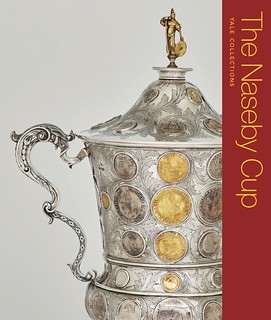 One of the most exceptional numismatic objects in the world, the Yale University Art Gallery's Naseby Cup was commissioned by John and Mary Frances Fitzgerald, Lord and Lady of the Manor at Naseby, in Northamptonshire, England. It commemorates the Battle of Naseby on June 14, 1645, during which the forces of the English Parliament, led by Oliver Cromwell and Sir Thomas Fairfax, defeated the Royalist army of King Charles I. Crafted by silversmiths Charles Reily and George Storer and completed in 1839, the intricately decorated Victorian cup stands more than two feet tall and features 72 coins, medals, badges, and counters from around the time of the English Civil War period (1642–51).
One of the most exceptional numismatic objects in the world, the Yale University Art Gallery's Naseby Cup was commissioned by John and Mary Frances Fitzgerald, Lord and Lady of the Manor at Naseby, in Northamptonshire, England. It commemorates the Battle of Naseby on June 14, 1645, during which the forces of the English Parliament, led by Oliver Cromwell and Sir Thomas Fairfax, defeated the Royalist army of King Charles I. Crafted by silversmiths Charles Reily and George Storer and completed in 1839, the intricately decorated Victorian cup stands more than two feet tall and features 72 coins, medals, badges, and counters from around the time of the English Civil War period (1642–51).
Many of these numismatic pieces are rare, such as a New England shilling from 1652 and a copy of an original 1644 Oxford crown of Charles I, which depicts the king on horseback and a view of the city. The cup is innovatively designed so that both the front and back of each piece are visible, one on the cup's exterior, one on its interior. Integrating numismatics into the larger study of both art and history, this publication offers an in-depth look at the Naseby Cup and its many layers of meaning.
144 pages
8 1/4 x 9 3/4 inches
185 color illustrations
Distributed by Yale University Press
2024
Paperback with flaps
ISBN 978-0-300-27586-5
$25.00
For more information, or to order, see:
The Naseby Cup: Coins and Medals of the English Civil War
(https://artgallery.yale.edu/publication/naseby-cup-coins-and-medals-english-civil-war)
The Naseby Cup: Coins and Medals of the English Civil War
(https://secure.touchnet.net/C20510_ustores/web/product_detail.jsp?PRODUCTID=1557&SINGLESTORE=true)
To read earlier E-Sylum articles, see:
THE NASBY CUP
(https://www.coinbooks.org/v23/esylum_v23n23a19.html)
PRATT GALLERY SHOWCASES MONEY AND MEDALS
(https://www.coinbooks.org/v25/esylum_v25n27a18.html)
NEW BOOK: THE YEHUD COINAGE
The following article alerted me to this new book published by the Israel Numismatic Society. -Editor
The Yehud Coinage
A Study and Die Classification of the Provincial Silver Coinage of Judah
by Haim Gitler, Catharine Lorber and Jean-Philippe Fontanille
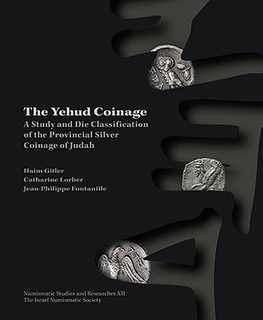 This volume presents a die study of the provincial silver coinage of Judah in the late Persian, Macedonian, and early Hellenistic periods. It offers correct descriptions of the coins, their designs, and their inscriptions; enumerates the obverse and reverse dies identified for each of the 44 recorded types; and explains the probable sequence of the issues as deduced from iconographic associations and die links.
This volume presents a die study of the provincial silver coinage of Judah in the late Persian, Macedonian, and early Hellenistic periods. It offers correct descriptions of the coins, their designs, and their inscriptions; enumerates the obverse and reverse dies identified for each of the 44 recorded types; and explains the probable sequence of the issues as deduced from iconographic associations and die links.
The iconography of the coin types is examined in depth, with comparisons to motifs in Greek, Persian, and ancient Near Eastern art, including other local coinages and sources in Judahite material culture. The monograph also analyzes data relating to the metrology, metal content, and circulation of the coinage. Overall, the study attempts to place the Yehud coinage in its historical context and to define its role in the economy of the ancient province of Judah.
xii,532 pages (illus.)
Numismatic Studies and Researches, 12
Israel Numismatic Society
Language: English
Hardback (June 2023)
ISBN-13 9789655982299
ISBN-10 9655982297
$150.00
PDF eBook (December 2023)
ISBN-13 9789657849002
ISBN-10 9657849004
$150.00
For more information, or to order, see:
The Yehud Coinage
(https://isdistribution.com/BookDetail.aspx?aId=168567)
The Yehud Coinage: A Study and Die Classification of the Provincial Silver Coinage of Judah (Numismatic Studies and Researches, 12) Hardcover – June 1, 2023
(https://www.amazon.com/Yehud-Coinage-Classification-Provincial-Silver/dp/9655982297)
2024 SHEKEL PRIZE ANNOUNCED
The Shekel Prize is awarded annually to the best book published on the topic of ancient Judaean coins, coins of the Holy Land or Judaic numismatics. Here's the announcement of the 2024 winners. -Editor
Mel Wacks, President Emeritus of the American Israel Numismatic Association, has announced
that the winners of the 2024 Shekel Prize are the co-authors of The Yehud Coinage
- a
comprehensive work weighing in at over 6 pounds and 832 pages. The die study was originally
carried out by Jean-Philippe Fontanille, with commentary by Dr. Haim Gitler and Catharine
Lorber. Gitler, Lorber and Fontanille are residents of Israel, the United States and Canada,
respectively.
A Yehud coin was first published in 1814 by Taylor Combs, Keeper of Coins and Antiquities at the British Museum, featuring a mysterious seated male figure on a winged wheel. Interestingly, no other example of this type has ever been discovered.
 The volume, published by the Israel Numismatic Society, presents a die study of the provincial
silver coinage of Judah in the late Persian, Macedonian, and early Hellenistic periods, ranging
from about 350 – 262 BCE. It offers precise descriptions of the coins, their designs, and their
inscriptions; enumerates the obverse and reverse dies identified for each of the 44 recorded
types; and explains the probable sequence of the issues as deduced from iconographic
associations and die links. The iconography of the coin types is examined in depth, with
comparisons to motifs in Greek, Persian, and ancient Near Eastern art, including other local
coinages and sources in Judahite material culture. The monograph also analyzes data relating
to the metrology, metal content, and circulation of the coinage. Overall, the study attempts to
place the Yehud coinage in its historical context and to define its role in the economy of the
ancient province of Judah.
The volume, published by the Israel Numismatic Society, presents a die study of the provincial
silver coinage of Judah in the late Persian, Macedonian, and early Hellenistic periods, ranging
from about 350 – 262 BCE. It offers precise descriptions of the coins, their designs, and their
inscriptions; enumerates the obverse and reverse dies identified for each of the 44 recorded
types; and explains the probable sequence of the issues as deduced from iconographic
associations and die links. The iconography of the coin types is examined in depth, with
comparisons to motifs in Greek, Persian, and ancient Near Eastern art, including other local
coinages and sources in Judahite material culture. The monograph also analyzes data relating
to the metrology, metal content, and circulation of the coinage. Overall, the study attempts to
place the Yehud coinage in its historical context and to define its role in the economy of the
ancient province of Judah. The Yehud Coinage
is available on amazon for $150.
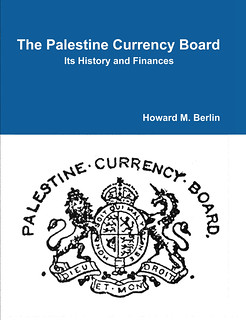 The Shekel Prize Committee also awarded a Special Commendation to Dr. Howard Berlin,
author of a definitive study
The Shekel Prize Committee also awarded a Special Commendation to Dr. Howard Berlin,
author of a definitive study The Palestine Currency Board, Its History and Finances.
This book
traces the need and development for a native Palestine currency, culminating with the formation
of the Palestine Currency Board which administered the Palestine Mandate's new monetary
system. Unlike Britain's imperial pound-shilling-pence monetary system, the newly created
Palestine pound was a decimal system divided into 1,000 mils and used the British pound
sterling as its anchor currency. Established June 15, 1926, the Palestine Currency Board
remained in effect for 26 years until it was dissolved on March 31, 1952, nearly four years after
the State of Israel was established on May 14, 1948. The softcover version is available on
amazon for $40.95.
The rarest 100 Palestine banknote (1927 100 pounds) was sold in an auction in England in 2022 for £140,000 ($173,000). Less than 10 are known to exist.
To read the earlier E-Sylum article, see:
NEW BOOK: THE PALESTINE CURRENCY BOARD
(https://www.coinbooks.org/v26/esylum_v26n13a11.html)
BOOK REVIEW: DATED COINS OF ANTIQUITY, RELEASE 2
David L. Vagi submitted this review of the second release of Edward E. Cohen's Dated Coins of Antiquity. Thank you! Impressive review of an impressive work. -Editor
Dated Coins of Antiquity, Release 2 (DCA2), by Edward E. Cohen. Classical Numismatic Group, Inc., Lancaster, PA, 2023. Two volumes, hardbound. 907 pages. $195 from the publisher.
When Mr. Cohen's Dated Coins of Antiquity originally was released in 2011, it was a monumental addition to numismatic literature. Ever since, its value has been proven worldwide among catalogers, dealers, curators, scholars, researchers and collectors who rely upon it to perform their work with accuracy and efficiency.
The release of DCA2 a dozen years after the original is an achievement on similar scale, if such a thing is reasonable to state. It's not merely an update or slight revision, but a significant expansion of a work that most users might believe held little room for improvement.
It's worth pointing out that few books on ancient coins offer such broad utility. Though many outstanding works have appeared in recent decades, most are, by the nature of their chosen subject, narrowly focused.
Cohen's work is considerably different: a comprehensive survey, listing every dated ancient ‘Greek' coin issued before the lifetime of Jesus Christ (and some beyond) which the author has encountered in the literature and the marketplace.
As a veteran researcher, Cohen would be the first to admit a work of this kind is never ‘finished,' as discoveries are destined to emerge the moment a magnum opus like this goes to press. Those rare and exciting finds aside, DCA2 is masterful and authoritative, and will serve its intended purpose long into the future.
Users will be thankful that the author has done all the heavy lifting, distilling his in-depth findings into a single, eminently useful work.
The sheer magnitude of Cohen's understanding of how ancient Greek coins were dated is made clear in these two volumes. His ability to work with different calendar systems, scripts and varying approaches to dating, continues to impress in DCA2, where he makes it easy for non-specialists to draw conclusions.
We may start with the obvious: the page count of DCA2 is 40 percent greater than its predecessor, and at more than 900 pages, it has been appropriately divided into two volumes.
The hardcovers are glossy and durable, the binding strong, and the paper of the ideal weight and finish to allow these books to endure the daily use to which so many copies will be subjected.
Cohen has located enough new dated coins to increase his number of citations by more than ten percent, and in doing so has added more than 100 new coin types.
There is a significant expansion in the reported dates (and sometimes, types) for mints in Phoenicia, Nabataea, Characene and Elymais. The Ptolemaic listings are bolstered to 125 pages, with tables and notes to help users identify coins which often prove challenging – even to veteran catalogers.
The book's basic format has not changed, assuring those familiar with his earlier work will navigate this new work with equal efficiency.
Because DCA2 is such a significant expansion over its predecessor, the author has restructured its order, this time adhering to a more intuitive order of geographical location of issuing authorities (while keeping intact the listings for kingdoms which struck coins at mints spanning several regions). This, the users will find, is an improvement over the first release.
The expansion and re-organization demanded a new numbering system, which Cohen makes as painless as possible by citing the original DCA number at the point of listing. He also collects these numbers in a table of concordance, which is sure to be the first stop for those working with the benefit of an original DCA number.
The reader is well served by Cohen's dutiful citation of other references, such as standard works and auction appearances, which guide the reader to where they'll find another example of a coin they're researching. This is especially useful for those seeking die matches or looking to compare aspects of style or fabric with a specimen they possess.
The work is well illustrated, with enlarged color photos of most of the more than 1,200 types given a DCA2 number. In many cases, these illustrations are supplemented with enlargements of the portion of the design where the date appears.
It's no slight that the vast majority of the 10,000+ coins listed are not illustrated. However, DCA2 indicates the date as it appears on each of these coins, so it does not hinder identification. To illustrate an example of every coin listed would require at least another decade of diligent work and would expand the present work by several thousand pages.
Users will benefit from appendices the author includes for geographical locations, people, and obverse and reverse designs. Another useful feature is Cohen's extensive bibliography, listing the sources from which he mined so much of his information.
The scope of Cohen's research over the last several decades has given him an excellent understanding of the rarity of various Greek coins, which he shares with the reader for each coin type, or in some series, by individual date.
Cohen's estimations of rarity, which are presented throughout the work, reflect his experience in
recording specimens he's encountered in the marketplace. To guide readers, he offers a table in
which the ratings (common
through R3
) are described and explained.
The rarity ratings are intuitive, and readers will find them useful. Cohen's ‘time-sensitive' definition of rarity incorporates an important (and often underappreciated) component: an expectation of how long a collector who searches diligently might have to wait for the chance to acquire a specimen.
Users will also benefit from the upgraded photographic treatments in listings for the royal coinage of Bithynia, Armenia, and the Seleucids, as well as for pre-Imperial cistophori.
One field in which Cohen is especially invested as a researcher is the silver coinage of Tyre, which he covers here well beyond the lifetime of Jesus Christ, up through the apparent cessation of the series in A.D. 65/6.
His listing for Tyre is comprehensive, even exceeding that which appears in his separate publications on the subject. It includes a number of previously unreported dates and overdates (each with a photograph) as well as revised rarity ratings (by date). Further, it adds gold mnaieia of two dates, based on examples in the Staatliche Museen zu Berlin and the Bibliothèque Nationale de France.
As I reach the end of this review, I'm compelled to echo the sentiments of my review of the first publication of DCA so many years ago, for DCA2 is everything that the original proved to be, and so much more.
There is no question that DCA2 is an extraordinary book of immediate and lasting value. It is a worthwhile acquisition not only for its authoritative contents, but as an economical, compact option to the substantial library one otherwise would have to acquire to possess the kind of information Mr. Cohen's book offers on so diverse a selection of ancient coins.
For more information, or to order, see:
Dated Coins of Antiquity, Release 2 (DCA2), two-volume set, $195
(https://cngcoins.com/Coin.aspx?CoinID=396425)
GORDON WELLS BERG (1936-2024)
E-Sylum Feature Writer and American Numismatic Biographies author Pete Smith submitted this article on the late dealer and show promoter Gordon Berg. Thanks, Pete! -Editor
 This week I attempted to write a biography of Gordon Berg. I found there was a remarkable
shortage of information. His name appears in the Newman Numismatic Portal about 960 times.
This week I attempted to write a biography of Gordon Berg. I found there was a remarkable
shortage of information. His name appears in the Newman Numismatic Portal about 960 times.
There are hundreds of references to the Baltimore show but there is little personal information. I did business with him and always enjoyed talking with him at shows in the 1980's. I bought a large copper medallion from him that was featured in one of my exhibits.
Gordon was born on February 24, 1936. Census records show a Gordon W. Berg born in Ohio in 1936, the son of Rolland (1901-1947) and Sophia Berg. However, their connection to the coin dealer is unconfirmed.
Gordon was married to Marilyn Sacks Berg with a daughter. I frequently saw her sitting at his table at coin shows. I did not find an announcement of their engagement or wedding date.
A small amount of personal information was included in a 1999 article in Numismatic News. He started pulling coins out of circulation at age 12. While he was in college and graduate school. he had two part-time jobs and did a little coin dealing on the side. His story might be shared with many coin dealers.
He received a master's degree in business administration and got a job with the government. On weekends he set up at local coin shows. The article did not name the school or his employer.
Gordon W. Berg joined the ANA and started attending the ANA shows in 1964. He converted to life membership in 1976 as LM-1965. The Numismatist records a long series of small contributions to the ANA. These were likely needed to earn points for table placement at ANA conventions.
In 1971, Berg was the bourse chairman for a local coin show. He wanted to promote education and community involvement and thought he could produce a better show. He formed a partnership with Don Greenberg and they invited Ed Kuszmar to join them in producing the shows. At times they offered free tables and meeting rooms for coin clubs.
There is more information on the Baltimore show than on its promoter. The show changed its name and location several times. Some articles referred to it just as the Gordon Berg Coin Show.
The Suburban Washington D.C. Coin Show was at the Ramada Inn, in Lanham, Maryland, for two years 1973-1974 with about 60 tables.
The 3rd through 15th Suburban Washington D.C. Coin Show also known as The Suburban Washington D.C. Coin Convention was at the Sheraton Inn in Lanham, Maryland, in 1975-1987 with 140 tables.
The 16th to 29th Suburban Washington / Baltimore Coin and Currency Convention was at the
Baltimore Convention Center 1988 to 2001 with 295 tables. The Suburban
name continued to
be mentioned for several years after the name was changed.
Gordon Berg and Ed Kuszmar were both presented with an ANA Presidential Award in 1998.
The Baltimore Coin & Currency (Expo, Show) Convention was at the Baltimore Convention Center in March, July and November with Gordon Wells Berg as Bourse Chairman and Ed Kuszmar as Publicity Chairman in 2002-2006. In 2005 they advertised their future show dates through 2010.
I attended two Baltimore shows in 2005. I recall dealing with Ed Kuszmar on bourse issues. If Gordon Berg was there, I don't recall seeing him.
In 2006, the Baltimore show was sold to Whitman Publishing and it became the Whitman Baltimore Show, also known as the Whitman Baltimore Coin & Currency Convention, held three times a year.
Gordon Berg died on January 20, 2024. His obituary mentioned his wife and daughter but offered no recap of his life or career.
Edward Kuszmar died on November 7, 2022, and got an obituary in The Numismatist. Gordon Berg got his name listed without an obituary. I thought he deserved better.
Julian Leidman writes:
"Gordon was a long time dealer and had a table directly opposite me in Baltimore. He enjoyed early US type coins and later various tokens, medals, and other presidential items. He traveled extensively around the US and had bourse tables at many shows. I attended his funeral. There were a few local coin dealers in attendance.
Stephanie is his daughter and he has a granddaughter, as well. Prior to numismatics, he was a federal employee and served in the US Army."
Thanks, everyone. I recall those Lanham shows, which I travelled to a few times in the 1980s. Can anyone add more information or stories about Gordon? -Editor
AN EASTER EGG HOARD
Newman Numismatic Portal Project Coordinator Len Augsburger provided the following Easter Sunday report. Thanks! -Editor
An Easter Egg Hoard
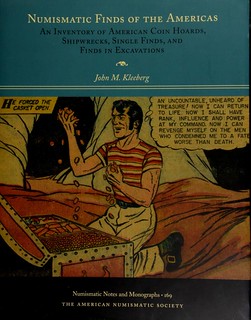 Did you ever discover coins during an Easter Egg hunt? The May 1956 Numismatic Scrapbook reported a find of Spanish silver coins, discovered in beach sand while planting eggs for an egg hunt. John Kleeberg picks up the thread in Numismatic Finds of the Americas (entry 433), which describes the contents as
Did you ever discover coins during an Easter Egg hunt? The May 1956 Numismatic Scrapbook reported a find of Spanish silver coins, discovered in beach sand while planting eggs for an egg hunt. John Kleeberg picks up the thread in Numismatic Finds of the Americas (entry 433), which describes the contents as Spain, Charles III, 2 reales (pistareens), 1780-1784 (6).
Kleeberg helpfully adds a reference to the New York Times of March 30, 1956, which reported Charles Holland, a workman cleaning the beach preparatory to hiding the eggs, raked up a half dozen old Spanish coins…Beach officials posted a watch at the scene to prevent trampling on the sand before the egg hunt. A number of adults had appeared with digging equipment to seek more of the coins.
One can imagine their disappointment upon excavating a rotten egg instead of a Charles III pistareen!
Image: Front cover of Numismatic Finds of the Americas (Numismatic Notes and Monographs no. 169, 2009).
Link to Numismatic Finds of the Americas:
https://nnp.wustl.edu/library/book/519183?page=139
2024 NEWMAN GRANT DEADLINE NEARS
Len Augsburger also reminds us of the upcoming deadline for applications for the 2024 Newman Grants. Don't miss out - if you've got a great idea and could use some help with research expenses, please do consider it. Previous recipients have made excellent contributions to numismatic research. What great project do YOU have in mind? -Editor
 2024 Newman Grant Deadline Nears
2024 Newman Grant Deadline Nears
The Newman Grant program, sponsored by the Eric P. Newman Numismatic Education Society (EPNNES), annually awards grants for the purposes of original research in numismatics. This year's program was previously announced in the January 28, 2024 E-Sylum, and the deadline for applications is April 15. Applications may be found on the Newman Numismatic Portal at https://nnp.wustl.edu/library/archivedetail/530553?Year=2024 and should be submitted to NNPCurator@wustl.edu. Grant awards will be announced on May 25, 2024, coincident with the late Eric P. Newman's birthday.
To read the earlier E-Sylum article, see:
2024 NEWMAN GRANT PROGRAM ANNOUNCED
(https://www.coinbooks.org/v27/esylum_v27n04a10.html)
VIDEO: FUTURE OF THE ANA, APRIL 2005
The David Lisot Video Library on the Newman Numismatic Portal can be found at:
https://nnp.wustl.edu/library/multimediadetail/522852
We highlight one of his videos each week in The E-Sylum. Here's one from 2005 with Executive Director Chris Cipoletti. -Editor
Hear the overview of the future of the American Numismatic Association as explained by Executive Director Chris Cipoletti. He discusses plans and programs that have been implemented as well as his vision of the future. These include:
- mission statement of the ANA to help people discover and explore the world of money
- expanded program offerings and traveling exhibits
- success of Coins in the Classroom to help educate teachers
- announcement of a new annual magazine, budget challenges, fundraising initiatives, partnerships with other organizations, and consumer protection programs.

Speaker(s): Christopher Cipoletti.
If only we knew what actually lay ahead. -Editor
To watch the complete video, see:
Future of the ANA, April 2005
(https://nnp.wustl.edu/library/book/557172)
WHITMAN BRANDS IS BORN
Looking forward to the future of numismatic publishing in the U.S., in his Spring 2024 CPG Market Review, Editor Patrick Ian Perez of the Greysheet discusses the recent merger of CDN Publishing with Whitman Publishing. -Editor
As I mentioned in my last Editor's message, towards the end of last year CDN Publishing acquired and subsequently merged with Whitman Publishing and their associated brands. At that time, we were still in the process of naming the new entity and trying to wrap our collective heads around the scope of the project. After careful deliberation and consideration, we landed on Whitman Brands. While there was an initial thought to create an innovative new brand name, it was recognized that the historic Whitman name had significant value. Thus, Whitman Brands was born. In the ensuing months, the personnel of the combined companies have been meeting with and learning about each other, in order to build a well-oiled numismatic publishing and data machine. From a personal standpoint, it has been invigorating to meet and work with new team members. I can feel that everyone has a singular focus to provide our hobby with resources to greatly enhance the collecting experience, and there has been much work done to this end.
Some of the earliest-ripening fruits of this labor will be both a refresh of long-appreciated titles and brand-new books for numismatists to enjoy. The team has been hard at work on the Sixth Edition of The Cherrypicker's Guide, Volume 3. For those who may not be familiar, The Cherrypicker's Guide is a reference book of United States coin varieties that have proven to be among the most popular, most widely collected, and most valuable. The third volume (of three) covers half dollar coins up through silver dollars, classic gold, modern Silver Eagles, and even U.S.-Philippines coinage. The sixth edition will feature all new updated coin values that are generated directly from our extensive pricing database. This will further represent a unification of pricing across multiple platforms.
Another exciting release is authored by the writer of this issue's featured article. The book by author Michael Moran will be a comprehensive look at the history of United States coinage and the politics behind them. Each of the coin types so familiar to collectors today have a fascinating and oftentimes complex story behind their design and creation. As an example, in these pages you can read a first-hand account of what it takes to get a commemorative coin program through the legislative process. Many collectors may not be familiar with our government's requirements on how the Mint receives authorization to create various coinage. The roots of this process go back to the earliest days of our nation, to the establishment of the Mint in 1792. Perhaps the most popular and well-received U.S. commemorative coins over the past decade-plus, the 2021 Morgan and Peace dollars almost didn't happen. It is a fast-paced account, but it also highlights that U.S. citizens can still make an impact and work with elected representatives to reach a common goal. This is certainly encouraging!
To read the complete article, see:
Editor's Message: CPG Market Review Spring 2024
(https://www.greysheet.com/news/story/editors-message-cpg-market-review-spring-2024)
Here's some more from the new company website. -Editor
 CDN Publishing and Whitman Publishing have united, creating a historic moment in numismatic history.
CDN Publishing and Whitman Publishing have united, creating a historic moment in numismatic history.
Whitman's legendary brands, such as the revered Red Book, Blue Book, and an expansive line of folders, albums, and supplies, have long dominated the retail landscape. Meanwhile, CDN Publishing boasts esteemed wholesale brands like Greysheet, Greensheet, CPG, CDN Exchange, and the Banknote Book.
Whitman Brands marries CDN's data-driven wholesale expertise with Whitman's retail prowess, offering a comprehensive and intellectually rich coverage of collectibles. Embrace the heritage, explore the vast array of publications, and become part of a movement that celebrates the richness of numismatics.
To visit the new Whitman Brands website, see:
https://whitmanbrands.com/
NOTES FROM E-SYLUM READERS: MARCH 31, 2024
George Ohr Coins at the Kirkland Museum
Ted Puls writes:
"I got to go play at the Kirkland Museum in Denver and took pictures of the George Ohr coins that they have on display."
Thanks. Museum quality! -Editor
To read the earlier E-Sylum articles, see:
GEORGE OHR: THE MAD POTTER OF BILOXI
(https://www.coinbooks.org/v27/esylum_v27n05a21.html)
NOTES FROM E-SYLUM READERS: FEBRUARY 11, 2024 : George Ohr Works at the Kirkland Museum
(https://www.coinbooks.org/v27/esylum_v27n06a13.html)
The Pugilist Sower
Wayne Pearson writes:
"This is hilarious."
It's the French Two Euro coin for the 2024 Olympic Games. Love it! -Editor
To read the complete lot description, see:
France 2 euro 2023 Olympic Games 2024 coin eurocoin UNC
(https://www.ebay.com/itm/125804703929)
Here's some more information. -Editor
One hundred years after the Paris 1924 Olympic Games, the French capital will once again host the Summer Games in 2024. One year before the launch of the Olympic Games, the Monnaie de Paris is continuing the celebration by counting down to the start of the Games by highlighting its heritage and that of Paris. An event with international echo whose intensity gradually increases in the years leading up to the event, with already several €2 commemorative coins dedicated to the Olympic Games over the past years.
The design of the coin depicts the Sower, a national figure and icon of French numismatics, practicing pugilism, the forerunner of boxing, in reference to the Antic Olympic Games. Her silhouette is in the foreground in front of the Pont-Neuf and its surroundings, typical of the Ile de la Cité area, a key element of the Parisian landscape. In the background, an athletic track, into which the emblem of Paris 2024 is inserted on the right-hand side, is represented. The year date, the RF mention and the mintmarks are inserted under the arch, on the bridge railing and in the Seine.
To read the complete article, see:
Olympic Games Paris 2024
(https://economy-finance.ec.europa.eu/euro/euro-coins-and-notes/euro-coins/commemorative-coins/olympic-games-paris-2024-0_en)
New Book on Slabbed Coins
David Pickup writes:
Don't forget the Encyclopedia of Slabbed Coins is now available with chapters on:
-
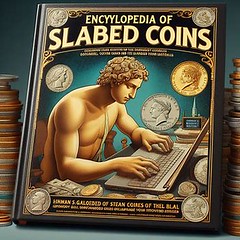 Slabbing through the ages
Slabbing through the ages
- Slabs: the hoard evidence
- Oriental slabbing where holes are punched in the middle so they can be tied up with string
- Curious and primitive slabbing
- Para-slabbing where token slabs were issued to use instead of plastic
- Slabbing plastic coins – what is the point?
- Colonial slabbing
- And finally Slabbing Chocolate coins for Christmas
The book comes in a protective permanently sealed cover to keep the contents clean.
Just send £99.00 in cash (not slabbed) to Aprille Phoole Publishing.
1912 First Strike Coins
Roger Burdette writes:
"Here is a letter to the Secretary of Treasury. I've never heard of this for ordinary coins, but possibly one of your readers has some insights."
Jan. 3, 1912.
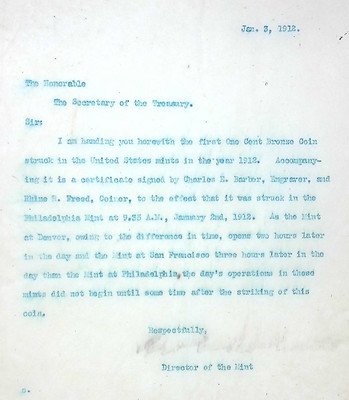 The Honorable
The Honorable
The Secretary of the Treasury.
Sir:
I am sending you herewith the first One Cent Bronze Coin struck in the United States mints in the year 1912. Accompanying it is a certificate signed by Charles E. Barber, Engraver, and Rhine R. Freed, Coiner, to the effect that it was struck in the Philadelphia mint at 9:35 A.M., January 2nd, 1912.
As the mint at Denver, owing to the difference in time, opens two hours later in the day and the mint at San Francisco three hours later in the day than the mint at Philadelphia, the day's operations in those mints did not begin until some time after the striking of this coin.
Respectfully,
Director of the Mint
Very interesting - a first strike certificate from the U.S. Mint. Does anyone have more information about this practice? Have any such coins turned up with an accompanying certificate? -Editor
THE BOOK BAZARRE
SHOEMAKER'S CHANGE-MAKING DILEMMA
In an echo of the old "Josh Tatum" gold-plated "no cents" Liberty nickel story, Jim Haas came across this March 16, 1917 article about confused denominations, this time during a paper money design changeover. The story is from College Point, NY. -Editor
Jim writes:
"Were the $5.00 note so similar to the $1.00 note he could have made the mistake? The unfortunate College Point cobbler had to learn the hard way."
Jim supplied these images to illustrate the potential design confusion. -Editor
Well, the centered portrait and large red seal are common elements, but any never-before-seen note is a novelty, and having been told it's the new five I could imagine someone being distracted looking at all the new design features and overlooking the denomination. Such mistakes are far more likely to happen when new designs are first released and people haven't gotten used to seeing them. The five's denomination is repeated five times and is prominently featured in the corners of the note, but the one's denomination is only stated twice and only in one corner. -Editor
IMPORTANT
THINGS
Max Hensley edits Scripophily magazine for the International Bond & Share Society (IBSS). He passed along this commentary on Important
Things in public auctions. Thanks.
-Editor
I'm on the Sotheby's promotion email campaigns so I get notice of all the big
things Sotheby's is offering for sale or auction. It used to be, years ago, when that venerable firm offered mostly old things with provenance and intrinsic value – antiques, paintings, coins, etc. Important
is the term they applied to Louis XV ormolu-mounted girandoles. In that time, life was somewhat predictable and, well, language still had meaning.
So, I was shocked by an email notice of a March 26 Sotheby's sale of
Important Sneakers and Modern Collectibles
. One word I do not associate
with sneakers
is important
. Smelly, torn, fungus, stained, dirty, maybe. But not important
by any stretch of the imagination.
What was Sotheby's thinking about? Here's the partial lot description of one of
those important
sneakers:
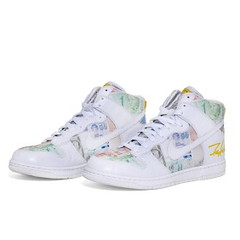
The Nike Dunk High FLOM Livestrong White Sample offered is a true unicorn
that embodies the creative vision of Brooklyn native Leonard Hilton McGurr, widely known as Futura. As one of the pioneering figures of the New York City graffiti movement, Futura's innovative approach to street art has left an indelible mark on contemporary culture. Renowned for his abstracted blending of text and imagery, Futura's influence extends beyond the realm of graffiti, encompassing collaborations with icons like The Clash and contributions to esteemed institutions such as the Musée de Vire and the Museum of the City of New York.
A frequent Nike collaborator, one of Futura's many achievements was the Nike SB Dunk High FLOM, a legendary sneaker featuring a tiled pattern crafted from various denominations of printed money (emphasis added). With purportedly fewer than 25 pairs in existence, mostly distributed among friends and family, these sneakers attained mythical status, becoming highly coveted by collectors. The exclusivity of the pair intensified demand, far exceeding the limited supply.
$80,000 start price in a timed auction, where it evidently did not sell. Not to be discouraged, another exotic shoe did sell for $23,320, a coveted Nike SB Dunk Low Pro ‘Freddy Kreuger Salesman Sample.
The next time someone complains about the price of some stock or bond, you
can point to these. Dear, it was cheap at the price. Just imagine if I had started collecting sneakers!
MSNS APRIL 2024 EDUCATIONAL PROGRAMS
The upcoming Michigan State Numismatic Society convention will feature a number of educational presentations. Here's the press release. Great lineup! -Editor
All meetings are in the Macomb Room!
ANA President Tom Uram
ANA Update and
Morse Code on Money
 Newly elected ANA president Tom Uram will be coming to Michigan to speak at the MSNS Spring Convention. In addition to providing an update about ANA, he will also be doing a presentation titled
Newly elected ANA president Tom Uram will be coming to Michigan to speak at the MSNS Spring Convention. In addition to providing an update about ANA, he will also be doing a presentation titled Morse Code on Money
. Having been involved in collecting since he was a child, he still loves to present to others sharing his numismatic knowledge.
Tom is an exceptionally good exhibitor and is well known in all areas of numismatics. He has been a delegate to presidential conventions since 1980. Extremely well connected, he was instrumental in having the legislation passed that enabled the passage of the circulating Morgan and Peace dollar in early 2021. During 2023, along with current CSNS vice-president Brett Irick, he was invited as a member of the public to the U.S. Mint Director's Conference in Washington, D.C. He was chairperson of the CCAC- (Citizens Coinage Advisory Committee)- in addition to being the president of the Pennsylvania Association of Numismatists. In his professional life, he owns a investment/advisor company in Western Pennsylvania.
Pat Heller, Communications Officer, Liberty Coin Service
State of the Industry
 Pat Heller has been a fixture in numismatics for a long time. Besides being the owner of Liberty Coin Service for many years, he has also given back to the hobby in many ways, including assisting the Attorney General of Michigan in consumer protection and doing the research to eliminate sales tax on Michigan rare coins and precious metals, effective July 7, 1999. This research has been used in many other states to achieve the same end. He belongs to many clubs, including life membership in ANA, CSNS, MSNS, National Silver Dollar Roundtable, SPMC, NLG, FUN and TNA. He gives talks on many topics and consults with many organizations that need advice on numismatic matters.
Pat Heller has been a fixture in numismatics for a long time. Besides being the owner of Liberty Coin Service for many years, he has also given back to the hobby in many ways, including assisting the Attorney General of Michigan in consumer protection and doing the research to eliminate sales tax on Michigan rare coins and precious metals, effective July 7, 1999. This research has been used in many other states to achieve the same end. He belongs to many clubs, including life membership in ANA, CSNS, MSNS, National Silver Dollar Roundtable, SPMC, NLG, FUN and TNA. He gives talks on many topics and consults with many organizations that need advice on numismatic matters.
Growing up with the hobby, as his father worked in the foreign aid program, he began collecting coins in 1964. He focuses now on writing, speaking and other public relations work for Liberty.
Pat has also received many honors, including the George Hatie award (MSNS' highest award) in 2003, the Presidential Award from MSNS in 2011, the Numismatic Ambassador Award at FUN in 2019, The Numismatic Literary Guild Award in 2019 and 2020 for the best investment publication, and the Glenn Smedley Award from ANA in 2018 for service to the hobby.
All talks and meetings are in the Macomb Room!
Paper Money Collectors of Michigan Meeting
Jim Burdick
Using "Numismatic Archeology" Techniques to Discover New Potential - How to Use Coins, Medals & Tokens to Preserve History
 This seminar will explain a technique that the presenter, Jim Burdick a life member of the Grand Rapids Coin Club, describes as "numismatic archeology", to identify new potential collecting possibilities that can be applied to any area of the hobby. French & other world numismatics will be explored, starting from revolutionary war times up to the early 1900s and industrial revolution. Jim will demonstrate how coins, medals and tokens have been used to tell history showing examples from his collection of Napoleonic era medals and jetons (French for token) to art medals displaying different engraving techniques. This presentation might be one of the last opportunities to view an elaborate "type set" of attractively toned and professionally graded numismatics & exonumia before it hits the auction block (varieties from Julius, Bramsen, Lerouge, Gad, Feuardent, Divio, etc.). Come learn how to discover new market opportunities. As Jim says, "You can't take it with you, but you can pass it on!".
This seminar will explain a technique that the presenter, Jim Burdick a life member of the Grand Rapids Coin Club, describes as "numismatic archeology", to identify new potential collecting possibilities that can be applied to any area of the hobby. French & other world numismatics will be explored, starting from revolutionary war times up to the early 1900s and industrial revolution. Jim will demonstrate how coins, medals and tokens have been used to tell history showing examples from his collection of Napoleonic era medals and jetons (French for token) to art medals displaying different engraving techniques. This presentation might be one of the last opportunities to view an elaborate "type set" of attractively toned and professionally graded numismatics & exonumia before it hits the auction block (varieties from Julius, Bramsen, Lerouge, Gad, Feuardent, Divio, etc.). Come learn how to discover new market opportunities. As Jim says, "You can't take it with you, but you can pass it on!".
Jim Burdick, a Life Member of the Grand Rapids, MI Coin Club, has been collecting since his youth. He learned about coins starting with a Boy Scout merit badge then inheriting a small collection from his grandfather. A business leader by day, he has been studying the numismatic markets for over 20 years, which allows him to use his analytical skills and love of art and history. As an Eagle Scout, he learned a saying, "as a boy scouting was good to you, as a man be good to scouting". That embodies how he feels about the numismatics community, willingly sharing his insights and lessons learned. A bit of an eclectic collecting dabbler, searching for underappreciated coins. He enjoys what he calls "numismatic archeology", preserving history by protecting numismatic treasures and with storytelling and research articles for his club. One area he has specialized in is French medals and tokens called "Jetons". He spends his winters coin collecting and ski patrolling and summers exploring Michigan's great outdoors and biking.
YN Luncheon and Auction
Join Mike Dennany and others in an interesting talk and auction for all Yns and their parents and others. Always a good time, you will learn something and get to bid on some great coins and other items of numismatics! Pizza is always provided!
Steve Bieda - Michigan's Innovation Dollar Progress Report
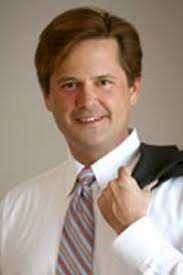 Steven M. Bieda was appointed by Gov. Gretchen Whitmer to the 37th District Court effective February 1, 2023. A lifelong Warren resident and Cousino Sr. High graduate, Bieda received his Bachelor's Degree in public Affairs with minor in Psychology and Masters in Public Administration from Wayne State University, Juris Doctor from the University of Detroit Mercy School of Law, and Masters of Tax Law from Wayne State Law School. Prior to his appointment to the bench, Judge Bieda was an appointee of Governor Whitmer as Chairperson and administrative law judge with the Michigan Tax Tribunal, serving from 2019 to 2023. He also served in the Michigan House of Representatives and the Senate, leaving due to term limits.
In addition, Steve is also very knowledgeable in many areas of numismatics, having designed the reverse of the 1992 U.S. Olympic Half Dollar, and contributed to the design of the Michigan quarter issued in 2004. He also designed a medal for the Capital building in Lansing.
Steven M. Bieda was appointed by Gov. Gretchen Whitmer to the 37th District Court effective February 1, 2023. A lifelong Warren resident and Cousino Sr. High graduate, Bieda received his Bachelor's Degree in public Affairs with minor in Psychology and Masters in Public Administration from Wayne State University, Juris Doctor from the University of Detroit Mercy School of Law, and Masters of Tax Law from Wayne State Law School. Prior to his appointment to the bench, Judge Bieda was an appointee of Governor Whitmer as Chairperson and administrative law judge with the Michigan Tax Tribunal, serving from 2019 to 2023. He also served in the Michigan House of Representatives and the Senate, leaving due to term limits.
In addition, Steve is also very knowledgeable in many areas of numismatics, having designed the reverse of the 1992 U.S. Olympic Half Dollar, and contributed to the design of the Michigan quarter issued in 2004. He also designed a medal for the Capital building in Lansing.
Steve will be speaking to us about Michigan's Innovation Dollar, which is slated to appear in 2025, and show us the possible designs of the dollar coin, and ultimately which one was selected. Come and learn about real coins coming down the pipeline for collectors!
For more information, see:
https://www.michigancoinclub.org/
PANEL: ISLAMIC COINAGE
The City University of New York is sponsoring a panel on Islamic coinage during the Byzantine and Sassanian Empires. -Editor
THE INTRODUCTION OF ISLAMIC COINAGE IN 697-98: THE BEFORE AND AFTER
Friday, April 5, 2024
12:00 pm — 2:00 pm
Join the Circle for Late Antique and Medieval Studies for a panel discussion on Islamic coinage during the Byzantine and Sassanian Empires.
What were the stages through which Islamic coinage was established in 697-698 CE? How did the Byzantine and Sasanian coinage transition during this process of change? What were the new Islamic motifs? And why did old coinage survive in the East?
Three distinguished historians/numismatists will discuss these questions:
Stuart D. Sears, Independent Scholar
Stefan Heidemann, Professor of Islamic Studies Universität Hamburg, Asien Afrika Institut
Michael Bates, Curator Emeritus of Islamic Coins American Numismatic Society
This panel discussion will take place online only. Please REGISTER VIA ZOOM to participate.
Stuart Sears is an Arabic translator and independent scholar who writes on numismatics and the social and political thought of the late antique and early medieval Near East. Formerly taught early Islamic history at The American University of Cairo, Winner of the Quadrennial Prize of the Royal Belgium Numismatic Society (1997). Articles include The Tale of Two Cities: Al-‘Abbasiyya and the Rise of the Aghlabid State,
Festchrift for Michael L. Bates (2020), 259-69; and The Revolt of b. al-?arith b. Surayj and the Countermarking of Umayyad Dirhams in Early Eighth Century CE Khurasan,
in The Lineaments of Islam. Studies in Honor of Fred McGraw Donner. Ed. Paul Cobb. In Islamic History and Civilization. Studies and Texts. Vol. 95. Leiden and Boston: Brill, 2012. 379-405.
Stuart Sears will present on The Politics of Believing: The ‘Standing Caliph' as Righteous Warrior. Few coin types of the early Muslims have piqued the interest of modern writers more than the tentatively named Standing Caliph with Symbol on Steps.
The distinctly Muslim coins appear across Syria at the end of the seventh century CE. Nevertheless, they bear little outward resemblance to the all-epigraphic Reformed coins that follow them. Their obverses bear the standing figure of a caliph or war leader girded with sword and whip. Their reverses have a pillar crowned with an orb on top of three or four steps. This paper argues that the type appeals in its iconography to the same themes as the Reformed type does in its legends. It not only invokes the ruler's duty to impose right authority but also defines this authority as a form of absolute kingship. These motifs draw on late Antique and Qur'anic tropes. In this context, the type elucidates the socio-religious legitimation of ‘Abd al-Malik's government in a manner not previously possible.
Stefan Heidemann has served, since 2011, as Professor of Islamic Studies at Universität Hamburg, and director of RomanIslam Center of Comparative Empire and Transcultural Studies
in Hamburg (2020-2025). PI of the ERC Advanced Grant Project The Early Islamic Empire at Work – The View from the Regions Toward the Center
(2014-2019), and editor-in-chief of the Journal Der Islam. Formerly he served as Associate Curator of Islamic Art at the Metropolitan Museum and as Professor of Islamic History and Material Culture at The Bard Graduate Center, New York. Habilitation at Jena University 2001. PhD at Free University Berlin 1993; Cooperation with German, British, French, and Syrian archaeological missions in al-Raqqa, Damascus, Aleppo, Masyaf, Balkh, Karakorum and other sites.
Professor Heidemann will speak on ‘Abd al-Malik (r. 685-705) was the architect of the Imperial formula of the Islamic Empire, who gave it its expression. This included the design of the naturally ubiquitous coinage. The transition from the Byzantine cross potent on steps on the gold coinage to a different image or symbol was necessary. The first symbols which were invented to replace the Byzantine cross had only a short-lived success. It was soon replaced by something, which expresses the sovereignty of God in the Empire much more appropriate: the ‘Surat of Pure Faith' from the Qur'an. To understand this crucial transition at the beginning of the Islamic civilization better this preliminary symbol will be analyzed.
Michael L. Bates, from Kentucky, was educated at Valley High School, Valley Station, Ky., and at the University of Chicago (A.B., ‘63, Ph.D., ‘75). He joined the American Numismatic Society in September 1970 and was promoted to Curator of Islamic Coins in 1977, retiring in 2005. He was an officer of the International Numismatic Commission, 1979-91; Numismatist, Fustat Excavations, 1978, 1980, 1981-82 (with an American Research Center in Egypt Fellowship); Consultant and Curator, Numismatic Collection, Museum of Islamic Art, Kuwait, 1981-85; Visiting Fellow at Oxford University, UCLA, and the University of Toronto.
Michael Bates will speak on Sasanian-Type Coinages after the Introduction of Muslim Arabic Coinage in Iran
. In 697-98 the caliph Abd al Malik and al-Hajjaj, his governor general for the lands of the former Sasanian empire, introduced a coinage of entirely new design, bearing only Islamic religious inscriptions in Arabic and some simple decorative elements, to replace the former Muslim silver coinage that continued the imperial Sasanian design. At least 42 mints have been recorded on dirhams of 79 Hijri, the first full year of issue, including mints outside Iran where no coins had been produced before, and others in the next few years. The quantity of surviving Islamic dirhams is huge. There can be no doubt that the caliph and the governor were serious in their intent to replace the old coinage, depicting a Sasanian emperor and a Zoroastrian fire altar, with a new inscriptional Islamic issue. And yet, plenty of the old coins, including the last issues, still survive today. More surprisingly, old style coins of the eastern mints dated well after the year of the reform are generally common. How could it happen that old style coins continued to be produced after their intended abolition? A first step toward an answer is to find out when and where these various coins were produced, or pretended by their inscriptions to have been produced, in the postreform years. In a century of serious study of these issues, no one has yet attempted to map and date this production. An accurate picture is only beginning to be delineated; the first results will be shown.
The Circle is convened by Parvaneh Pourshariati, Associate Professor of History at the New York City College of Technology/CUNY, under the auspices of the Ralph Bunche Institute for International Studies and with the support of the History Program and Middle East and Middle Eastern Americans Center.
To read the complete article, see:
THE INTRODUCTION OF ISLAMIC COINAGE IN 697-98: THE BEFORE AND AFTER
(https://www.gc.cuny.edu/events/introduction-islamic-coinage-697-98-and-after)
CONFERENCE: FROM SOLIDUS TO STAVRATON
Princeton University is planning a conference devoted solely to Byzantine numismatics. Here's the announcement. Great idea! To be held on April 26-28, it is free and open to the public. -Editor
From Solidus to Stavraton: Coinage and Money in the Byzantine World
April 26-28, 2024
This three-day international conference, to be held at Princeton University will be the first ever devoted solely to Byzantine numismatics, and it will reunite renowned scholars and specialists from Europe, Asia, Africa, and the U.S.
The acquisition of the collections of Peter Donald and Chris and Helen Theodotou, totaling over 17,000 coins, has placed Princeton University at the forefront of institutions supporting research in Byzantine numismatics. Both of these purchases were made with the help of generous support of the Friends of Princeton University Library and the Seeger Center for Hellenic Studies.
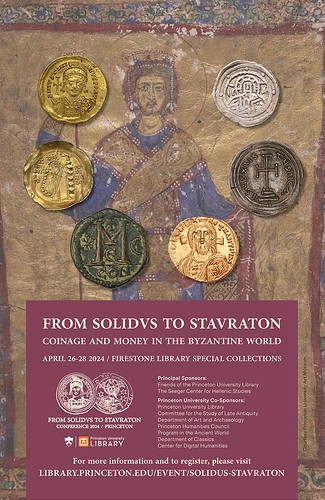 Among the activities that we have initiated to accompany these acquisitions are the cataloging of the coins onto the Princeton University Library catalogue; the development of a shared-open-data web platform for Byzantine coinage in collaboration with scholars at Dumbarton Oaks, Oxford University, and the American Numismatic Society; and the planning of this conference "From Solidus to Stavraton."
Among the activities that we have initiated to accompany these acquisitions are the cataloging of the coins onto the Princeton University Library catalogue; the development of a shared-open-data web platform for Byzantine coinage in collaboration with scholars at Dumbarton Oaks, Oxford University, and the American Numismatic Society; and the planning of this conference "From Solidus to Stavraton."
During the first two days, a total of 22 academics will present their updated research to colleagues, scholars, students, and members of the general public.
The last day will be dedicated to a workshop that will aim at bringing the scholars together and finalize the Linked-Open-Data database of Byzantine coinage. This platform, established with the Nomisma ontology, is an international collaborative project, created to provide stable digital representations of numismatic concepts according to the principles of Linked Open Data, while maintaining formalized RDF Ontologies. It will become a vital tool for consultation by scholars, numismatists and general public around the world. Furthermore, the tool will be open to institutions from different countries, enabling them to contribute their evidence to the database.
For more information, or to register, see:
From Solidus to Stavraton: Coinage and Money in the Byzantine World
(https://library.princeton.edu/EVENT/SOLIDUS-STAVRATON)
SYMPOSIUM: MONEY, WAR AND MORE
Money, War and More
is the theme of the Second Annual Numismatics Symposium presented by Nickle Galleries and the Calgary Numismatic Society (CNS), taking place April 27-28, 2024.
-Editor

The Money, War and More symposium examines the interplay between money, power and the capacity to wage war, starting in the ancient era and progressing through to the present,
explains Marina Fischer, curator of numismatics at Nickle Galleries at the University of Calgary. It shows the crucial importance of economic power as the basic underpinning of all strategic considerations and strategies. This event hopes to draw attention to a connection between the history of war and money, an aspect of military power that is often ignored.
The April 27-28 symposium offers ten numismatic presentations by several experts from across Canada. It also includes two workshops that will assist collectors in Making Good Purchases
and better understanding Tools for the Coin Collector.
To read the complete article, see:
Symposium explores links between money and war
(https://canadiancoinnews.com/symposium-explores-links-between-money-and-war/)
For more information, or to register, see:
2nd Annual Numismatics Symposium
Money, War and More
(https://nickle.ucalgary.ca/wp-content/uploads/2024/01/program-2024.pdf)
VOCABULARY TERM: PHOTOGRAPHY
Here's another entry from Dick Johnson's Encyclopedia of Coin and Medal Terminology. This one has some terminology for bibliophiles. -Editor
Photography. Creating continuous-tone graphic images of coins and medals for use to illustrate articles, catalogs, books, advertisements. Coin photography is a branch of macro photography – closeup photography. Factors of lighting, focus and sharpness of detail are important factors in this field of photography. The intent is to show detail, often that is not that apparent to the naked eye, but is not just a magnified image.
Coin and medal photographs, other than identification photographs to identify a particular specimen, are mostly used for printed illustrations. However, a revolution has occurred in this field, from chemical photography to digital photography. Now coins and medals can be scanned and the digitized image stored on computer and retrieved for any printed illustration, circumventing the camera-to-negative-to-print-to-printing plate process.
A computer image can be enlarged (until the pixel is revealed), the image can be altered to vary the color, a nick or dent or stain can be removed, as well as other massaging. Thus the need remains for the old time photograph to be used for magnification of the surface of a coin or medal, for objects too large or difficult to be scanned, and of course for scenes, portraits and such.
History of coin and medal illustrations. Prior to the widespread use of photography about 1850, illustrations had to be engraved by line engraving (also called surface or flat engraving to differentiate it from die engraving). Thus coins and medals were represented by line drawings rather than the actual item itself. In 1830 an attempt was made to make line drawings by machine (like a ruling pen), but this required a cast replica of the original otherwise the original might be damaged by the tracing stylus (see anaglyptography).
Once photography was invented it made for ideal illustrations of the actual items and some numismatic books were illustrated by actual photographic plates bound in the books. Even then the lighting was such a problem for a group of items (particularly that were different metals, each with a different reflective surface) that coins and medals were often cast into plaster, and the plaster replicas, all of one hue, were photographed! This process continued even until the 1930s.
With a photographic image some process was necessary for rendering it into a plate which could be reproduced by printing. Halftones were perhaps the most successful, but this broke up the image into tiny dots (from 60 to 200 per linear inch). Coarse paper would limit the fineness of the screen of the halftone (newspaper ranged from 60 to 80, machine made paper up to 150, and coated paper up to 200). Several processes to reproduce the continuous tone were developed (as colotype and others) but had limited use.
Thus what was once a major problem for every numismatic book publisher – the photography of coins and medals – has now come to rely on the computer-generated image (CGI). This book is illustrated with CGI illustrations. A scanned image can be made directly from the item itself, entered into the computer, stored, refined, changed, enlarged or reduced, all by computer. When it comes time to reproduce the image it is easily printed and this serves as the master for modern printing processes.
To read the complete entry on the Newman Numismatic Portal, see:
Photography
(https://nnp.wustl.edu/library/dictionarydetail/516479)
A DICK JOHNSON BIOGRAPHY
Stack's Bowers Numismatist Chris Bulfinch wrote a nice article about the life and work of the late Dick Johnson. See the next article in this issue for selections from the upcoming Stack's Bowers sale of Dick's collection. -Editor
Stack's Bowers Galleries is honored to be offering the D. Wayne Johnson (better known as Dick Johnson) Collection of art medals, coins, non-art medals, tokens, numismatic art, and assorted exonumia in a series of sales in 2024, starting with the April 17 Collectors Choice Online Auction of Tokens and Medals.
Richard Wayne Johnson, known as D. Wayne Johnson or Dick Johnson, was a well-known collector of tokens and medals, author of numerous books and articles on art medals and associated terminology, numismatic terminology, and hobby news. He was a talented cataloger and numismatic historian who was a fixture in the world of art medals and the broader numismatic community for well over half a century. Additionally Johnson was active in numerous numismatic organizations over the course of his long and varied career.
Richard Wayne Johnson was born in Kansas City, Missouri on August 27, 1930. Growing up in the Midwest, mainly in Kansas City, the greater Chicago area, and New Orleans, he reported that his interest in numismatics dated to February 1939 when his father gave him a Whitman Penny
board. An early ambition, which he realized many times over the course of his professional life, was to serve as the editor of a numismatic publication.
Johnson served in the Air Force from 1950 to 1954 and attended his first national coin convention in 1951. From the 1950s and 1960s onward, he formed strong connections with many of the most accomplished numismatists of the period including Q. David Bowers, Eric Newman, Walter Breen, and Ken Bressett. With this cohort Johnson cofounded the Rittenhouse Society in 1957, a club of eminent numismatists that continues today. He also served in different officers' roles in multiple Midwestern numismatic clubs. His foray into numismatic publishing began when he helped establish the Middle Atlantic Numismatic Association and coedited its journal with Walter Breen. He wrote longer form, more serious content under the byline D. Wayne Johnson and shorter form pieces under the moniker Dick Johnson, a sobriquet used by many friends and fellow numismatists. Later in the 1950s, he worked for a printing firm and the Kansas City Kansan as he began his career in numismatic publishing.
An oft-cited entry in Johnson's numismatic biography is his central role in establishing Coin World magazine. He served as Coin World's first editor for 18 months, from the publication's establishment in spring 1960 through mid-1961. Short though his tenure at Coin World was, Johnson remained an active contributor to numerous publications and founded another – Coin Wholesaler, which was sold to Space City Numismatics of Houston, Texas. From that firm he launched another publication, called Pace.
Over his career, he contributed many articles on art medals, medalists, and other numismatic topics to a wide variety of publications including The Numismatist, Coins, and Coinage. In the internet age, his online contributions were also prolific, including many articles in E-Sylum, the weekly electronic newsletter of the Numismatic Bibliomania Society. For decades he maintained a database of research he had done and regularly published a blog. His body of work includes lengthy explanations of various terms and concepts relating to medal and exonumia production and collecting and constitutes a valuable resource of collectors looking to sharpen their knowledge.
Though in this biography the term exonumia
is used, this might have chagrined Johnson, who did not believe that the term exonumia
included art medals. His initial criticism was in a 1960 Coin World published after the term was coined by Russell Rulau at a meeting of prominent numismatists (including Johnson) that took place before the 1960 American Numismatic Association convention in Atlanta. In his writings on the subject Johnson differentiated between art medals and token medals (medals struck on a coining press), the latter he grouped in with tokens as a class of non-coin collectibles described as exonumia. He elaborated on these distinctions in his published work.
He published several books late in his life, including Monograms of American Coin and Medal Artists in 2010, Who's Who Among American Medallists in 2015, and An Encyclopedia of Coin and Medal Technology in 2016. He also published Numismatic Directory 1957.
Johnson's name is indelibly associated with his extensive work at and with the Medallic Art Company, starting when he became Director of Research there in January 1966. Among his significant undertakings at MACO was cataloging the firm's 1907-1976 output, publicizing many of the firm's releases and writing speeches for its president. He edited MACO's company newsletter The Art Medallist. He worked at MACO until 1977, and when he left, the firm sold him 64,000 unwanted medals.
He later served as publicity consultant for MACO and as a medal consultant for firms and organizations, including the Carnegie Hero Fund Foundation and numerous museums.
With Chris Jensen, a fellow medal collector/aficionado, Johnson formed Johnson & Jensen in the spring of 1977; they transitioned the firm to Medallion House Incorporated in 1983. They conducted 27 sales from 1978 to 1985. Johnson cataloged and conducted eight more auctions into 1990. Johnson remained active in the industry and hobby throughout his life. In 2008 he co-founded Signature Art Medals, a firm dedicated to selling high quality medallic art and he returned to MACO in 2010, serving as the firm's Corporate Historian until it declared bankruptcy in 2017.
Over the course of his career, Johnson amassed a substantial collection of art and token medals, tokens, coins, and numismatic art. It includes quite a bit of MACO material, in addition to tokens and medals from Tiffany & Co., the United States Mint, and material designed by prominent American medallic artists and/or commemorating significant numismatic and medallic art organizations. Agricultural medals, So-Called dollars, trade tokens of different descriptions, a smattering of U.S. and world coins, and all manner of other medallic objects abound.
Johnson passed away on December 29, 2020, at age 90. He was inducted into the American Numismatic Association's Numismatic Hall of Fame in 2021, a capstone for a career that saw many other awards and decorations from hobby institutions. Today his name is associated with the institutions to which he dedicated his career, such as Coin World and MACO, and his reputation as a skilled numismatist and indefatigable researcher endures. His collection reflects his interest in art medals and traces the contours of his career.
The author of this tribute is indebted to the obituary published in the January 4, 2021, E-Sylum, as well as Johnson's own autobiography on his website and a 2003 Asylum article.
To read the complete article, see:
STACK'S BOWERS GALLERIES PRESENTS THE DICK JOHNSON COLLECTION
(https://stacksbowers.com/stacks-bowers-galleries-presents-the-dick-johnson-collection/)
To read earlier E-Sylum articles, see:
D. WAYNE JOHNSON (1930-2020)
(https://www.coinbooks.org/v24/esylum_v24n01a06.html)
RECOLLECTIONS OF D. WAYNE JOHNSON
(https://www.coinbooks.org/v24/esylum_v24n01a18.html)
A DICK JOHNSON E-SYLUM SAMPLER
(https://www.coinbooks.org/v24/esylum_v24n01a19.html)
DICK JOHNSON COLLECTION SELECTIONS
Stack's Bowers will be selling the collection of the late Dick Johnson in April. Here's the announcement and several selected lots. Some nice items, many seldom seen. See the previous article in this issue for more on Dick's life and work. -Editor
Stack's Bowers Galleries is pleased to present our first offering from the Richard Wayne (Dick) Johnson Collection. Johnson was the founding editor of Coin World and a noted expert on art medals along with a wide range of other numismatic topics and concepts. He spent the vast majority of his career in numismatics, working for the Medallic Art Company and operating his own firms that specialized in medals and art medals (a distinction in which Johnson placed great stock). He was well-known in U.S. numismatic circles, not least for his prolific contributions to a range of numismatic publications covering a wide range of topics.
This first presentation will feature medals struck by the illustrious firm Tiffany and Co. and includes scarce and esoteric types both vintage and modern. Medals in silver and bronze are represented in quantity and cover many topics, ensuring something of interest for nearly every collector. The collection as a whole provides a window into the medallic production of a firm that continues to operate today, and collectors will appreciate the opportunity to view it from a historical perspective.
Lot 71010 "1779-1780" (1889) Washington Association of New Jersey Badge. By J.H. Whitehouse, struck by Tiffany & Co. Musante-Unlisted, Baker-Y100. Silver. About Uncirculated.
Lot 71015 1914 Avery Library Medal. By Victor David Brenner, struck by Tiffany & Co. Smedley-102. Silver. Choice About Uncirculated.
Lot 71023 1908 American Numismatic Society Fiftieth Anniversary Medal with Oak Leaf Clasp. By Victor David Brenner, struck by Tiffany & Co. Miller-19. Silver. About Uncirculated, PVC.
Lot 71048 1858 New York Chamber of Commerce Atlantic Cable Completion Medal. First Size. By Tiffany & Co. Copper. About Uncirculated.
Lot 71053 1912 Niagara Medal. By Frederick William MacMonnies, engraved by Paulin Tasset. Struck by Tiffany & Co. Sterling Silver. Mint State.
Lot 71057 1917 Theodore Newton Vail Medal. By Tiffany & Co. Silver. About Uncirculated.
Lot 71058 1928 Banker's Trust Company Presentation Medal. By Tiffany & Co. Gold. About Uncirculated.
Lot 71067 1910 National Academy of Design, Isidor Memorial Medal. By Tiffany & Co. Gold. Mint State.
Lot 71068 1973 St. Paul's School Board of Trustees and President's Service Medal. By Tiffany & Co. Sterling Silver. Mint State.
Lot 71080 Undated (1995) National Academy of Recording Arts and Sciences 37th Annual Grammy Nominee Medal. By Tiffany & Co. Bronze. Mint State.
To view lots and bid, see:
April 2024 Collectors Choice Online Auction - The Dick Johnson Collection of Tiffany Medals - Lots 71001-71102
(https://auctions.stacksbowers.com/auctions/3-18XALX/april-2024-collectors-choice-online-auction-the-dick-johnson-collection-of-tiffany-medals-lots-71001-71102)
MDC MONACO AUCTION 14 HIGHLIGHTS
Here's the press release for the upcoming Auction 14 from MDC Monaco. Nice variety of great world coins and medals. -Editor
At MDC Monaco, we have the pleasure to announce our next numismatic auction n°14, which will take place at the Metropole Hôtel in Monaco, on Friday the 3rd, and Saturday the 4th of May, 2024. On this occasion, we will also present the collection of colonial coins from Jean Lecompte.
- First session, Friday the 3rd of May – 1h30pm – 7pm (Lots n°1 to n°689)
- Second session, Saturday 4th of May – 9:30am – 12am (Lots n°690 to n°1012)
- Third session, Saturday 4th of May – 1:30pm – 4:45pm (Lots n°1013 to n°1515)
- Fourth session, Saturday 4th of May – 5pm – 7pm (Lots n°1516 to n°1726)
Lot 23 - ANCIENT GREECE Mysia, Cyzicus. Stater of electrum ND (500-450 BC), Cyzicus.
Obv. Lion standing facing right, holding a sword in its mouth; below, a tuna facing right.
Rev. Quadripartite incuse square.
SNG France n° 322 - de Luynes N° 2457 - Von Fritze, Berlin, 1912, 177; Electrum - 16.01g - 15 x 22 mm - 12 h.
NGC Ch XF 5/5 3/5 Fine style. Perfectly centered strike on a spectacular oblong flan. High reliefs for the lion and the tuna, lots of details. One of the most beautiful known examples.
Starting price: 70,000 €
According to the legend, Cyzicus would have been built by Cyzicus, son of Apollo or more likely by the Milesians, during the 7th century BC. Built on the coast of Mysia, on the Propontis (sea of Marmara), this city is a crossroads between the Euxine (Black Sea) and the Aegean Sea, between Europe and Asia, between Thrace and Asia Minor (Anatolia). Thanks to its location, Cyzicus was an important trading place and a tuna fishing place, which made it a flourishing city, well-known for its beauty and wealth. It was also an important cultural center, with a school of Mathematics, many historians, renowned architects and other specialists.
Lot 111 - ROMAN EMPIRE Vitellius (69). Sestertius ND (69), Rome.
Obv. A VITELLIVS GERMAN IMP AVG P M TR P. Laureate and draped bust facing right.
Rev. L VITELL CEN - SOR II. Lucius Vitellius seated on a platform facing right. On the left, a man seated on another platform; at the bottom, three standing people, one holding the censor's hand.
RIC.134; Bronze - 24.72g - 34 mm - 6 h.
From the Cantoni collection, P. & P. Santamaria sale, November 29th 1920, n°433 (Pl.X) then M. Ratto sale, 1939, then Prof. Angelo Signorelli collection, Part II, P. & P. Santamaria sale, Rome, June 4th 1952, n° 1231
Very rare type, with L. Vitellius, father of Emperor Vitellius, and one of the most distinguished senators under the reign of Claudius, on the reverse. Remarkable pedigree, covering more than a century ! Dark patina in the hollows of the reliefs, with a majority of green concretions. Intact reliefs with a beautiful bust. Extremely fine.
Starting price: 25,000 €
Lot 125 - ROMAN EMPIRE Trajan Decius (249-251). Double sestertius 249-251, Rome.
Obv. IMP C M Q TRAIANVS DECIVS AVG. Radiate bust, draped and armored, facing right, three-quarter front view.
Rev. FELICITAS SAECVLI / SC. Felicity standing facing left, holding a tall caduceus and a cornucopia.
RIC.115c - C.39; Bronze - 39.01g - 36 mm - 12 h.
From A. Hess AG and Bank Leu AG 41 sale, 24th and 25th April 1969, n°451
Very large module ! Bright green patina on the obverse, and a flawless brown-green patina on the reverse. Exceptional quality for this type. Extremely fine.
Starting price: 15,000 €
Lot 132 - ROMAN EMPIRE Constantine II (337-350). Multiple or medallion of the weight of 2 solidi 327, Thessaloniki.
Obv. CONSTANTINVS - NOB C. Diademed head facing right.
Rev. In four lines: VOTIS / X / CAES. N/SMTS.
RIC 166 (Berlin, same dies) - C. 278 - Gnecchi I, 26, 22, pl.8/8 - Depeyrot (1995), p.154 = this exact coin; Gold - 8.78g - 26.5 mm - 12 h. From the Nelson Bunker Hunt collection, Sotheby's New York sale, June 21th-22th 1990 n° 871
NGC CH XF 5/5 3/5 marks. Only 2 known examples with the one in the Berlin Cabinet ! Minimal marks and scratches, and a tiny notch on the rim at 4 o'clock on the reverse. Well-centered with a remarkable portrait. Extremely fine.
Starting price: 100,000 €
Constantine II was the eldest son of Constantine the Great and his second wife Fausta, born in 316. Constantine I wanted to establish his own dynasty and granted his son the title of Caesar when he was only one year old. This medallion is struck for its tenth anniversary. Using a style first seen under the reign of his father, Young Caesar is looking at the sky. Medallions or multiples were gifts offered by the Emperor to high-ranking personalities. In our case, the medallion would have been offered by the young Caesar himself. In 326, his half-brother Crispus is disgraced and executed, as well as Fausta, under unclear circumstances. In 327, Constantine II was named commander of Gaul, replacing Crispus.
Lot 173 - GERMANY Hamburg (imperial city of). Portugalöser of 10 ducats, to the unity of the four major banking cities of Europe (Amsterdam, Hamburg, Nuremberg and Venice), by J. Reteke, prooflike, 1677, Hamburg.
Obv. QUATUOR HIS SIGNIS PYRAMIS AUCTA DOCET. Under God's name, a view of Hamburg and its port with boats. In the foreground, on the left, Abundance with a cornucopia, under an arm emerging from the clouds and crowning it. On the right, a pyramid on an altar, decorated with armorial shields, surmounted by an angel blowing a trumpet; below HAMBURG.
Rev. QUID PRUDENS CONCORS VIGILANS SOLLERTIA PRÆSTET. Facing allegories of Prudence, Concord and Vigilance, with their own attributes ; above radiating triangle ; below (date).
Gaedechens 1609 - Geschichte in Gold 88; Gold - 34.8g - 49 mm - 12 h.
NGC MS 61 PL. Prooflike with very detached reliefs from the mirror fields. Beautifully fresh, with its mint lustre, barely burnished with micro-marks in the fields and a few micro-scratches explaining this pretty severe technical grade. Uncirculated.
Starting price: €50,000
The portugalöser, worth 10 gold ducats, comes from the large portuguese cruzados which were circulating a lot in Germany. The State was the only one authorized to strike coins, so banks for example in Hamburg, issued these portugalöser as medals, but with a monetary value (with very precise weights). Those portugalöser were used to transfer money, particularly between the cities of the Hanseatic League.
Lot 190 - GERMANY Prussia, Frederick William IV (1840-1861). Box containing 3 medals in gold, silver and bronze, First performance of Antigone by Félix Mendelssohn in Berlin, by C. K. Pfeuffer 1841, Berlin.
Obv. Circular legend in Greek. Bust of Antigone with a beard, facing right; signature C. PFEUFFER FEC.
Rev. A circular wreath of ivy, with medallions of Medusa, Ludwig Tieck, musical instruments and Felix Mendelssohn, surrounding a religious scene of a woman approaching an altar; below legend in Greek.
Forrer IV p.475-476 - Niggl 1303 - Sommer P 72; Gold, silver and bronze - 278.12g, 145.25g and 142.8g - 63 mm - 12 h.
NGC MS 62 (Gold), UNC DETAILS OBV RIM DAMAGE (Silver) and MS 62 BN (Bronze). The box is slightly worn, with some gaps. The medals have tiny marks on the edge (12 o'clock for the silver one) and the fields are barely burnished by fingerprints. Extremely rare set. Uncirculated.
Starting price: €60,000
The original box, imitating leather with romantic floral decoration, includes the three medals in gold (278.12g), silver (145.25g) and bronze (142.8g). Antigone, a character created by Sophocles, refuses her uncle's and King Creon's orders. He symbolizes the opposition to the established order in many artistic representations. Frederick William IV was considering Greek tragedy as a way to revitalize cultural life in Berlin and commissioned Antigone from Felix Mendelssohn, a conductor in Leipzig. The play was performed for the first time on October 28th 1841, which was very successful.
Lot 232 - BELGIUM Leopold I (1831-1865). Module of 100 francs in gold, marriage of the Duke and Duchess of Brabant, Proof 1853, Brussels.
Obv. LEOPOLD PREMIER ROI DES BELGES. Bare head facing left, below signature L. WIENER.
Rev. L.L.PH. M. V. DUC DE BRABANT M. H. A. DUCHESSE DE BRABANT / 21-22 AOUT 1853. Attached busts facing right, below signature LEOP. WIENER.
Fr.6 - Dupr.538; Gold - 32.2g - 37 mm - 6 h.
Top Pop: this is the finest known example ! From Elsen 150 sale n° 1256
PCGS PR64CAM. Proof. Irregular rim following the marking of the edge. In its mint state with mirror fields and matte reliefs. Beautiful light with mint lustre barely colored.
Starting price: €30,000
Lot 273 - CAMBODIA Norodom I (1860-1904). Pattern of four francs, without signature, on gold flan, Proof 1860, Brussels (Würden).
Obv. NORODOM I ROI DU CAMBODGE. Bare head facing left, below (date).
Rev. QUATRE FRANCS. Legend and coat of arms of Cambodia.
Lec.71a = this example - Fr.2a; Gold - 24.95g - 34.4 mm - 6 h.
Top Pop: this is the only graded example ! From the Jean Lecompte collection. This is the coin illustrating the work of Jean Lecompte, Monnaies et jetons de l'Indochine française, published by Gadoury.
PCGS PR65 (unfinished Proof) plate coin. Proof with unfinished fields showing traces of field polishing. Exceptional gold module, unique!
Starting price: €60,000
Lot 310 - COCHINCHINA Third Republic (1870-1940). Piastre de commerce pattern, Special Strike (SP) 1879, A, Paris.
Obv. REPUBLIQUE FRANÇAISE. The radiant Republic, seated, facing left and holding a fasces; below signature BARRE and (date).
Rev. COCHINCHINE FRANÇAISE / TITRE 0,900. POIDS 27,215. In a two branches' crown : ESSAI / PIASTRE DE COMMERCE / (different) (mint) (different). Lec.28 = this example; Silver - 39 mm - 6 h.
It is the third highest grade (3), only 1 example in 63+ and one in 65 are graded higher by PCGS. From the Jean Lecompte collection. This is the example illustrating the work of Jean Lecompte, Monnaies et jetons de l'Indochine française, published by Gadoury
PCGS SP63 plate coin. Special strike (SP) with the two anchors of the engraver Barre and ESSAI on the reverse. Low relief on the right thigh. Very few handling marks. Beautiful gray patina, dark on the obverse and showing golden reflections on the reverse.
Uncirculated.
Starting price: 25,000 €
Lot 315 - REPUBLIC OF KOREA Kojong (1864-1897). Proof set including five coins of 5 yang, 1 yang, 1/4 yang, 5 fun and 1 fun, Proof Year 501 (1892).
Obv. (value) and circular legend. In the center, two dragons facing each other.
Rev. In a plant crown formed by two composite branches, under a mugunghwa flower, two words.
KM.1114; Silver and bronze - 38 to 20 mm - 6 h.
With the original box decorated with a mugunghwa flower (or Sahron rose)
Proof. Cleaning traces.
Starting price: €40,000
Original set including five coins : silver 5 yang (26.91g - KM.1114 - NGC PF 61); Silver 1 yang (5.41g - KM.1112); cupro-nickel 1/4 yang (4.58g - KM.1109 - NGC PF 62 - Second highest grade (2) !); bronze 5 fun (7.09g - KM.1106 - NGC PF 62 BN - Second highest grade !) and brass 1 fun (3.59g - KM.1104 - NGC PROOF DETAILS ENVIRONMENTAL DAMAGE).
Lot 341 - SPAIN Amadeo I (1870-1873). 100 pesetas, yellow gold strike, raised lettered edge JUSTICIA Y LIBERTAD 1871, M, Madrid. Obv. AMEDEO I REY DE ESPANA. Head facing right with signature L. M. on the edge of the neck; below *(date)*.
Rev. LEY 900 MILLESIMAS 31 PIEZAS EN KILOG. / (different) 100 PESETAS (mint). Oval coat of arms surrounded by the Golden Fleece's collar and set on a crowned mantle.
Aureo & Calicó.11 - Cayon 17455 (25 examples) - Fr.340; Gold - 33.57g - 35 mm - 6 h.
Original strike in yellow gold : very rare ! Small handling marks and hairlines in the fields. Tiny notches on the rims. Beautiful color, with reliefs barely satiny.
Starting price: €100,000
The 100 pesetas coin is the first to bear the modern denomination of pesetas
, after centuries of striking 8 escudos and its divisions. Two dates are visible on the coin : in large numbers is the type approval date and in small numbers, in the stars surrounding the large date, the date of minting. A royal decree, in January 1871, specified the legend of the edge : Justice and Liberty. The Amadeo's 100 pesetas was struck according to the decree of the Treasury Department of August 22th 1871, and started with only a dozen original examples in yellow gold, of which six to eight examples would be known today.
Lot 374 - FRANCE / ROYAL Philippe VI (1328-1350). Gold crown ND (1340). Obv. + xPHx DIx GRAx REXx FRANCx. Royal crown surrounded by six lilies. Rev. + °XP'C: VINCIT: XP'C: REGNAT: XP'C: IMPERAT. Cross with leaves and acorns, a quadrilobe in the center, branchs separated by four crowned lilies, in a polylobe surrounded by clovers.
Dy.252 - Fr.275; Gold - 5.38g - 30.5 mm - 2 h.
PCGS MS62. Very few circulation wear with the flan barely bent. Beautiful golden color. Uncirculated.
Starting price: 30,000 €
Lot 377 - FRANCE / ROYAL Philippe VI (1328-1350). Florin Georges, 1st issue ND (1341), Angers.
Obv. (lily) PHILIPPVS: DEI - GRA' - :FRACOR': REX. Saint George riding a horse facing left, helmed and armored, carrying a crossed shield and holding a spear that he plunges into the mouth of the dragon terraced at the horse's feet; field of lilies; the whole scene in a polylobe interrupted at the top and the bottom.
Rev. + XP'C: VINCIT: XP'C: REGNAT: XP'C: IMPERAT. Cross with florets, quadrilobe in the center, in a quadrilobe decorated with leaves and separated by four lilies.
Dy.257 - Fr.272; Gold - 4.7g - 28.5 mm - 9 h.
The flan is pretty wide and the strike is well-centered, very discrete double strike on the obverse. Beautiful golden color. Rare.
Starting price: 50,000 €
Lot 933 - GREAT BRITAIN - UNITED KINGDOM James II (1685-1688). 5 guineas, 1st bust, with elephant and castle 1687, London.
Obv. IACOBVS. II. - DEI. GRATIA. Laureate head facing left; below (different).
Rev. MAG. BR. FRA. ET. HIB. REX (date). Cross composed by four crowned shields containing arms, and flanked by four scepters. S.3398 - GH 43 (38 examples, finest MS61+) - Bull.312 - Fr.293; Gold - 41.71g - 37 mm - 6 h.
Top Pop : this is the most beautiful graded example ! With the elephant and castle, indicating that the metal came from the Royal African Company, one of the oldest British colonial companies established in Guinea. Prestigious pedigree : H. Montagu Collection, Sotheby's sale, London, November 1896, n°842, sold as coming from the W. Brice collection (purchased in bulk by H. Montagu); then B.M.S. Roth Collection, Sotheby's sale, London, July 1917, n°349; then Lieutenant-Colonel T. G. Carter's collection, purchased by Spink, London, in 1936; then Dr. E. C. Carter's collection, purchased in bulk by Baldwin, London, in 1950 and sold in 1951 (£125); then, Slaney collection, Spink 3024 sale, London, May 2003, n°70 and finally private collection (Sincona British Collection)
NGC MS 63. Raised lettered edge : +. DECVS. ET. TVTAMEN. ANNO. REGNI. TERTIO. Exceptional strike, remarkable force and well-centered, the reliefs perfectly raised. Close to mint state, the original shine barely browned in the fields by a patina with orange tones. Exceptional and spectacular. Uncirculated.
Starting price: €200,000
Lot 944 - GREAT BRITAIN - UNITED KINGDOM George III (1760-1820). Gold pattern of the crown INCORRUPTA
, by W. Wyon, Proof 1817, London.
Obv. GEORGIUS III D: G: BRITANNIARUM REX. Laureate bust with draped collar facing right; below signature W. WYON and (date).
Rev. INCORRUPTA FIDES VERITASQVE. Scalloped and crowned shield, with arms of England, Scotland, Ireland and England, crowned shield of Hanover in the center.
Bull.2030 - Esc.230 - KM# PnC77 - WR.208; Gold - 48.69g - 38 mm - 12 h. Top Pop : this is the only graded example ! From a Stack's sale, January 14th 2008, n°2927 and previously DNW, September 2005, n°875 and SNC, December 1996, n°6009
NGC PF 65 ULTRA CAMEO. Proof and ultra cameo. Medal strike. The reliefs are matte with a grainy texture, creating a beautiful effect in strong contrast with the glossy and uniform mirror fields. Tiny hairlines. Exceptional rarity. A unique opportunity to acquire one of the most spectacular coin of British numismatics. Uncirculated.
Starting price: €350,000
William Wyon was born in 1795, son of Peter Wyon, and nephew of the chief engraver Thomas Wyon Sr. He began his career as an engraver in 1812, at only 17 years old, with a medal for the Society of Arts. In 1815, he created the great seals of Scotland and Ireland. In 1817, he joined the Royal Mint with his cousin Thomas Wyon Jr as second engraver. In 1817, the English government issued a new silver Crown and a new gold coin, the Sovereign. Produced in the new presses of the London mint, the type for those coins is Saint George slaying the dragon. The dies are the work of an outstanding Italian gem engraver, Benedetto Pistrucci. In 1816, when the project was launched, the young William Wyon proposed his model struck by the Royal Mint at only 18 examples in silver and 7 examples in gold. The reliefs of this pattern are treated in dotted lines, like the creations made for Cromwell. The bust is large and realistic, with great finesse. The Latin legend on the reverse INCORRUPTA FIDES VERITASQUE An Intact Faith
can be understood as the faith of the country towards its sovereign, often considered as a mad man but who nevertheless knew how to get his country out of long military conflicts. However, the project proposed by Pistrucci was ultimately chosen, which also allowed him to become chief engraver. To become chief engraver himself, Wyon had to wait another ten years, until 1828.
Lot 962 - GREAT BRITAIN - UNITED KINGDOM Victoria (1837-1901). Crown or Gothic Crown, Proof 1847, London.
Obv. VICTORIA DEI GRATIA BRITANNIAR. REG. F: D. in Gothic letters. Crowned bust of Victoria facing left.
Rev. (starting at 9 o'clock) TUEATUR UNITA DEUS / ANNO DOM MDCCCXLVII. Cross composed by four shields separated by four flowers. S.3883 - Esc.2571; Silver - 39 mm - 6 h.
PCGS PR65CAM. Raised lettered edge with 3 ferrules: (crown) DECVS * ET * TVTAMEN (crown) ANNO * REGNI UNDECIMO. Proof with cameo. Very nice patina with a satin bust. Proof.
Starting price: €50,000
Lot 1172 - INDOCHINA Third Republic (1870-1940). Pattern of the piastre, smooth edge, strike without ferrule, Special Strike (SP) 1921, San Francisco.
Obv. REPUBLIQUE FRANÇAISE. The radiant Republic, seated facing left and holding a fasces; below signature BARRE and (date).
Rev. INDO-CHINE FRANÇAISE / TITRE 0,900. POIDS 27 GR. In a two branches' crown: PIASTRE DE COMMERCE.
Lec.295 = this example; Silver - 42 mm - 6 h.
Top Pop : this is the only graded example ! From the Jean Lecompte collection and previously the A. Salles Collection, é. Bourgey, July 1st-2nd 1929, n°219 (illustrated plate III). This is the example illustrating the different editions of Jean Lecompte's work published by Gadoury
PCGS SP63 plate coin. Special strike as proof, no ferrule, from the San Francisco workshop. With a slightly shiny gray patina. Uncirculated.
Starting price: €30,000
Lot 1254 – ITALY Umberto I (1878-1900). Gold Medal, Umberto I of Savoy ascends the throne, by Speranza 1878, Rome.
Obv. UMBERTO I RE D'ITALIA - MARGHERITA DI SAVOIA REGINA. Bust attached facing left, the King with bare head, and the Queen laureate with an oak branch ; below signature SPERANZA.
Rev. QUESTA E' LA FEDE DELLA MIA CASA QUESTA SARA' LA MIA FORZA. In front of the throne where his helmet is placed, the King is standing, facing left, swearing on the constitution. In the background, in the nimbus, Carlo Alberto di Savoia and Vittorio Emanuele II as well as a Victory resting on the shield of Savoy and wearing a laurel wreath. Below : XIX GENNAIO MDCCCLXXVIII and signature SPERANZA.
Comandini 1878, p.709 - Martini cf. 3117 - Forrer V p.599; Gold - 243.63g - 69 mm - 12 h.
From Asta Finarte sale 786, May 7th to 9th 1991, N°805 (illustrated on the catalog's cover)
NGC MS 61. Special strike. Minimal scratches on the reliefs and hairlines in the mirror fields. Spectacular. Very rare in gold. Uncirculated.
Starting price: €30,000
Lot 1335 – POLAND Sigismund III Vasa (1587-1632). 80 ducats 1621 SA / II - VE, Bromberg (Bydgoszcz).
Obv. * SIGISMVNDVS* III* D: G: POLONIÆ* ET* SVECIÆ* REX*. Armored bust, bare head wearing a lace collar and a sash, adorned with the Golden Fleece's order. Below : signature S. A and small (date) behind the bust.
Rev. * MAGNVS* DVX* LITVAN: RVSS: - :PRVSS: MAS: SAM: LIVON: ZC':*. Quartered shield with arms of Poland at 1 and 4 (crowned eagle) and of Lithuania at 2 and 3 (galloping rider facing left, raising a sword and holding a shield), with shield of Sweden in the center, quartered with arms of Sweden at 1 and 4 (three crowns) and Gothie at 2 and 3 (crowned lion), with shield of Wasa in the center (sheaf). The whole shield crowned and surrounded by the Golden Fleece's collar ; above (date).
Fr.- - KM.F43 - Hutton-Czapski - - Kopicki.1443 - Kaminski.1768 - Dutkowski.95 - Kaleniecki p.106 (this example) - Jasek coins A/A; Gold - 282.54g - 69 mm - 12 h.
Top Pop : this is the only graded example ! From the Clifton-Wild collection acquired during Stack's sale of December 1995, n°820; previously from the Crédit de la Bourse sale, April 1992, n°806 and previously from the Julian Ursyn Niemcewicz collection and maybe from the Virgil Brand collection (who owned a 70, an 80 and a 100 ducats coins)
PCGS AU50. Light and regular wear on reliefs with small handling marks in the fields. Beautiful golden reflections around the reliefs. Impressive majestic bust. Exceptional museum coin ! Almost uncirculated.
Starting price: €1,300,000
By Samuel Amman, engraver (SA) and Jakub Jakubson Von Emden (II-VE), director of the Bromberg mint. Amman previously worked at the Danzig mint from 1610 to 1613, where his engravings were very neat. Exceptional in its size and beauty, this prestigious strike was probably created after the Battle of Khotyn during which the Polish-Lithuanian, who were catholics, defeated the Ottoman, who were muslims. It was the first major victory marking the end of the Ottoman expansion.
Lot 1499 - VIETNAM Annam, Khài Dinh (1916-1925). Gold 20 tiên (2 lang or 2 ounces) ND (1916-1925).
Obv. Surrounding a flaming pearl, a large dragon, head down and tail curled in a radiant sun on top ; on the right: Khài Dinh thông bao Current currency of Khài Dinh
and on the left: Van thê vinh lai Every generation will reap its fruit forever
; to the left and right, clouds.
Rev. In Chinese characters (Hanzi), a quatrain The precious stone khuyet and cinnabar in a thousand years are changed into very pure gold transmissible to ten thousand generations. That way, we recognize merit and we highlight virtuous men, because only wisdom is precious.
KM.- - Jewels - - Fr.- ; Gold - 74.2g - 56 mm - 12 h.
With suspension holes at 12 and 6 o'clock (a forged ring attached to the 6 o'clock hole). Exceptional module, weighting 2 gold ounces, and type, with the dragon descending on the obverse. The largest module for Thanh Thai is only one ounce (Schroeder 431, with a square hole). This example, intended for the King or a high dignitary, has been worn (the ring is at the bottom) and has a slightly cleaned appearance. Very rare, probably unique ! Extremely fine.
Starting price: €50,000
Since 2010, MDC Monnaies de Collection organizes every year numismatic auctions with printed catalogues. We present, on this occasion, rare and exceptional coins, banknotes, and medals, to an international clientele of enthusiast collectors. We also organize several e-auctions throughout the year.
For more information, or to bid, see
https://www.biddr.com/auctions/mdcmonaco/browse?a=4421
https://www.mdc.mc/
info@mdc.mc
WAYNE'S NUMISMATIC DIARY MARCH 31, 2024
Here's an addendum to last week's numismatic diary. First, here's more information on a couple interesting colonial pieces passed around the table at the March 2024 Nummis Nova meeting. Both were recent purchases from Jeff Rock's latest fixed price list. -Editor
In his introduction to the list, Jeff writes:
Let's face it. Rarities are cool. They make headlines when they
sell, and the most famous rarities seem to break record after record as more collectors want to own
these
trophy coins,
and have the resources to bid aggressively.…What often gets lost is that there are
still extremely rare coins – sometimes even unique ones! – that are available for a mere pittance, at
least if one looks beyond the most popular series. There is something special in knowing you have one
of only a couple examples of a variety known – or maybe the only one known – and the feeling is even
better when it did NOT cost you the equivalent of several houses in Southern California!
For this price list (#26) I decided to focus on rarities. Everything on this price list is Rarity-6 to Rarity-9 in nature – yes, with some unique things included! – with the exception of state coinages (other than Connecticut coppers) and Fugios, where the threshold was set at Rarity-5, simply because there are so few R-6+ varieties in those series that are currently available – or affordable… This focus solely on rarity means that there are more of certain types than usual, because that is where rarity and affordability intersect, especially St. Patrick's and Hibernia coppers, the French Colonies issues, and Connecticut coppers – though there is a wide offering of other series as well. While it is unlikely that a $100,000 New Jersey copper will double in value anytime soon, it only takes a couple new collectors to make a $500 Hibernia into a four-figure coin.
Agreed. Here are Jeff's descriptions. While a number of items sold quickly, I understand others remain available. For a copy of the list, write to Jeff at Rosaamltd@gmail.com . -Editor
A PRICE LIST DEVOTED TO AFFORDABLE RARITIES,
53. 1785
(i.e. 1863) Large Star Confederatio Cent, James Bolen Struck copy, Musante JAB-7, Kenney 2, W-14230. Rarity-6. Choice Extremely Fine. This is Q. David Bowers' own example of this very rare issue, now listed in the Whitman Encyclopedia. It was sold by Stack's Bowers in their January 2011 Americana sale, where it appeared as Lot 6599 and was described as follows:
Choice Extremely Fine. Obv. Diana at altar, INIMICA TYRANNIS AMERICANA around. Rev. Thirteen stars within circle of rays. CONFEDERATIO 1785 around. Smooth light brown surfaces, in fact largely the appearance of a high-grade colonial issue more so than a product of the 1860s. Likely among those artificially worn to pass as a genuine rarity, with even Bolen's secret mark carefully removed at the Y. Provenance: From the Q. David Bowers Collection; Charles Litman Collection; Donald M. Miller Collection.
One of just 30-40 examples struck in copper (Bolen's notebook gives the lower figure, while am 1882 work cited the higher number), these dies were defaced before they were sold, so no other perfect die state pieces could be struck. This example was worn down and almost certainly sold as an original at some point in the 19th century – easy enough to do prior to the publication of the Crosby reference which at least had an illustration of an original specimen that collectors could use to compare. But, as the Stack's Bowers cataloguer stated, this has the look and feel of a coin from the 1780s, on a copper planchet with the right look of the era, and the reverse centering of the Confederatio die a bit off, as one would expect for an original. Undoubtedly more than a few collectors were fooled by this piece, and in 1905 Bolen himself stated "although I have never thought or tried to pass one as genuine, I have often regretted having issued them as I have been informed that they have been worn or rubbed and made to look old, then sold as genuine." An Uncirculated example appeared in the November 2021 sale of the Anton collection and brought $3,840 (the description there well worth reading). This far more deceptive, lightly circulated
copy is more interesting to us, and one wonders just who it fooled!
67. 1792 Washington Roman Head Cent. Musante GW-21, Baker-19, W-1084. Rarity-6 as an original strike, probably of equal rarity as an electrotype. Choice About Uncirculated, an extremely well-made electrotype of this very rare and immensely popular coin, certainly the high water mark for the 1792 pattern issues, with finely engraved dies by the young John Gregory Hancock – though one could imagine that Washington's reluctance to have his image on a circulating coin would have been magnified a thousand-fold when that image was dressed up like a Roman emperor! Very light rub on the highest points, literally the definition of cabinet friction from a century or more of storage by collectors, but a lovely medium chocolate brown, the surfaces hard, but with some light hairlines that can only be seen with a glass. As an electrotype this lacks the normal lettered edge, and a faint seam where the two shells were joined can be seen on the plain edge. One of the legendary rarities of the Washington series, and a type where rarity usually joins condition – these were not made to circulate, though at least a couple did manage to slip into commerce (including a VG piece that sold at a Stack's auction in January 2009 for nearly $30,000!).
They were prized pieces for collectors in England, where they would have been collected alongside the popular Conder token series – though, oddly enough, the variety is not listed in Dalton and Hamer's work on those tokens (and even more oddly, the cover photo for the Quarterman reprint of that work is a Washington Roman Head cent – a piece not in the book itself!). By the 1860s, and likely a bit earlier than that, the type became known to American collectors – and an 1863 auction sold a fine copy
of one of these, likely an electrotype, as only a couple were known to American collectors. Indeed, an example was sold by W. Elliot Woodward in an 1864 auction for $480 – a sum that would have bought the unique 1794 silver dollar pattern in copper, plus a 1792 disme pattern, plus a half disme of the same year, with money left over! Today nice examples tend to sell in the $100,000 range, putting the 20 or so known examples out of the reach of most collectors. A lovely, carefully-made electrotype is not a bad way for those of us with much less deep pockets to obtain an example of this amazing artistic triumph in metal.
Walter Breen's fanciful claim of this being intended as a satirical piece has been widely disproven. Hancock was just 17 when these were made, and he clearly intended them for what they were. In Miss Banks's journals she notes only 6 were made – the number known today far exceeds that, and it is likely that Hancock or others struck further pieces to satisfy collectors.
And here are some interesting (and LARGE!) banknotes brought by Eric Schena. -Editor
Eric writes:
"Here are the two Vatican City horseblankets I brought. The one issued by the Banco di Sancto Spirito di Roma is for 15 (quindici) scudi and dated 7 January 1786. These notes were issued in literally hundreds of different denominations from 3 scudi to 3,000 scudi. The second note is from the Santo Monte Della Pietà di Roma for 95 scudi (novantacinque) dated 14 February 1798. This institution also issued these notes in hundreds of different denominations from 3 scudi top 1,500 scudi."
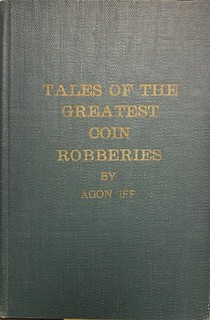
Finally, here's a book I saw offered this week and just couldn't resist adding to my library. The seller said little about its contents, and I'm really looking forward to finding out. I'm not even sure if the subject matter relates to the U.S., Europe, or worldwide. I'm not familiar with the book or its author, and Pete Smith claims it's not his nom de plume. The green cloth binding looks to be from the 1950s or 60s. -Editor
To read the earlier E-Sylum articles, see:
GREAT NUMISMATIC THEFTS
(https://www.coinbooks.org/v24/esylum_v24n08a15.html)
NNP ADDS SMITH'S NUMISMATIC ROGUES GALLERY
(https://www.coinbooks.org/v26/esylum_v26n53a05.html)
WAYNE'S NUMISMATIC DIARY: MARCH 24, 2024
(https://www.coinbooks.org/v27/esylum_v27n12a22.html)
MAUNDY COINAGE THEN AND NOW
Happy Easter. Here's an excerpt from a 2015 article by Andrew Crellin on the tradition of Maundy Coinage. -Editor
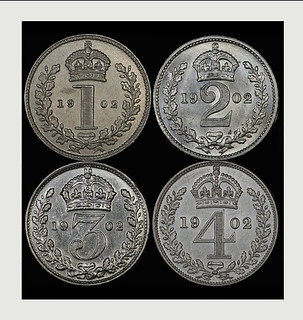 The first royal Maundy money ceremony took place when King Charles II gave people undated hammered coins in 1662. The distribution of coins to deserving citizens across the UK on Maundy Thursday continues today - Maundy coins have proven to be a rewarding, challenging and historic series of coins for collectors to acquire.
The first royal Maundy money ceremony took place when King Charles II gave people undated hammered coins in 1662. The distribution of coins to deserving citizens across the UK on Maundy Thursday continues today - Maundy coins have proven to be a rewarding, challenging and historic series of coins for collectors to acquire.
Many sources describe Maundy Thursday as the Christian holy day just before Good Friday, and that it commemorates the Last Supper of Jesus Christ with the Apostles. The term maundy
refers to the foot-washing ceremony that Jesus Christ originally performed on his disciples.
While a foot-washing ceremony will strike many non-Christians in the 21st century as being rather archaic, this passage of the Bible shows that Christ intended it to be a physical demonstration of the equality of all in the eyes of God - no man is so higher or lower than another that they cannot wash their brother's feet, or have them washed:
"If I then, your Lord and Teacher, have washed your feet, you also ought to wash one another's feet. For I have given you an example, that you should do as I have done to you. Most assuredly, I say to you, a servant is not greater than his master; nor is he who is sent greater than he who sent him. If you know these things, blessed are you if you do them."
There are many countries in the world where many churches of the Christian faith observe Maundy Thursday as part of Easter activities - Great Britain however is the only country in the world that has included silver maundy coins as part of the commemorations.
According to the Royal Mint, the tradition of royal maundy money
in Great Britain is thought to have started as early as the thirteenth century
, when …members of the royal family to take part in Maundy ceremonies, to distribute money and gifts, and to recall Christ's simple act of humility by washing the feet of the poor.
A royal Maundy coin has been struck for distribution in a set of royal Maundy money by the English monarch during royal maundy ceremony on Maundy Thursday. The four coin denominations that have been included in royal Maundy coin sets since 1670 are Fourpence (3d); Threepence (3d); Twopence (2d) and Penny (1d).
There are as many recipients of royal Maundy Money as there are years in the sovereign's age. At the royal maundy ceremony, the monarch hands each recipient two small leather string purses. A red purse contains ordinary coins, while a white one contains silver Maundy coins, amounting to the same number of pence as the years of the sovereign's age. In 2015, the Queen performed the pre-Easter tradition of handing out silver maundy coins to the elderly in Sheffield. The Queen handed out two purses – one red and one white to each of the chosen recipients. The white purse contained Maundy coins to the value of 89 pence, while the red purse contained a £5 and a 50p coin.
To read the complete article, see:
Easter's Maundy Thursday and Maundy Coinage
(https://www.sterlingcurrency.com.au/blog/news-research/world-numismatics/easters-maundy-thursday-and-maundy-coinage/)
In a dramatic change from tradition, this year's service was led by a stand-in for the ailing monarch. -Editor
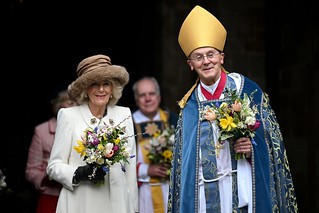 Queen Camilla participated in an ancient rite on Thursday that can be traced back to 600 A.D.—and marked a historic first by doing so. Camilla stood in for King Charles at the Royal Maundy Service at Worcester Cathedral, distributing gifts of coin purses to attendees, a ritual traditionally performed by the monarch at the pre-Easter service.
Queen Camilla participated in an ancient rite on Thursday that can be traced back to 600 A.D.—and marked a historic first by doing so. Camilla stood in for King Charles at the Royal Maundy Service at Worcester Cathedral, distributing gifts of coin purses to attendees, a ritual traditionally performed by the monarch at the pre-Easter service.
This is the first time a royal consort has ever distributed the traditional Maundy gifts solo, and the service is a highlight of the royal calendar. Charles's schedule of public engagements has been slimmed down due to his ongoing cancer treatments, and this is considered the most important occasion he has had to reallocate thus far.
Camilla was greeted at the historic cathedral by officials and given a small bouquet. She wore a white coat dress and tan boots, pinning gold and sapphire flower brooches to the coat's collar. The jewelry also bore a sentimental significance: The pins once belonged to the late Queen Elizabeth II, who attended the event almost every year during her 70 years on the throne.
During the service, Camilla distributed coin purses as a gift to 75 men and 75 women, the number of recipients a nod to Charles's age. Each giftee received a white purse with a custom silver Maundy coin and a red purse had a £5 Tudor Dragon coin, as well as a commemorative 50 pence coin in honor of the Royal National Lifeboat Institution's 200th anniversary.
To read the complete article, see:
Queen Camilla Stands in for King Charles in Historic First
(https://www.vanityfair.com/style/queen-camilla-stands-in-for-king-charles-in-historic-first)
The BBC and other news outlets interviewed some of the Maundy recipients. -Editor
To read the complete articles, see:
Norfolk and Waveney Christians at Royal Maundy service
(https://www.edp24.co.uk/news/24217858.norfolk-waveney-christians-royal-maundy-service/)
'I didn't think I was old enough for Maundy money'
(https://www.bbc.com/news/uk-england-lancashire-68683341)
NEVADA STATE MUSEUM'S DATSOLALEE MEDAL
Dat so? The Nevada State Museum has struck a new medal on trusty old Coin Press No. 1. -Editor
 The Nevada State Museum unveiled a new medallion in honor of Women's History Month on March 20, 2024.
The Nevada State Museum unveiled a new medallion in honor of Women's History Month on March 20, 2024.
The new medallion honors Dat So La Lee, the Queen of the Basket Weavers.
Dat So La Lee, or Louisa Keyser, was a prominent Washoe weaver at the turn of the last century. Her works of art are highly sought after to this day. The new medallion is second in the Women's History Series; the first was Agnes Train, one of the first women curators to work at the Nevada State Museum in the 1940s.
The new design was composed by Museum Exhibits Preparator Jeanette McGregor and sculpted by U.S. Mint sculptor Tom Rogers. The half-ounce .999 fine silver medallions are struck on historic Coin Press No. 1. This working artifact is the original coin press which made United States currency from 1870-1893 when Carson City hosted a branch of the United States Mint.
The Datsolalee medallion concept was approved and completed in conjunction with the Washoe Tribe of Nevada and California.
Louisa Keyser's (ca. 1850-1925) baskets are celebrated for their artistic beauty and technological excellence. She was best known by her Washoe name Datsolalee (wide hipped woman
) or Dat So La Lee, and her career parallels the history of the Arts and Crafts Movement in the United States. Her complex personal and unusual economic relationships with Emporium store owners, Abe, and Amy Cohn, allowed her to pursue her craft as their full-time ‘employee.' Despite their questionable promotion of her baskets and exploitation of an indigenous artist, they respected her as an individual closely tied to their family.
Dat So La Lee had the time to perfect her skills and experiment with her baskets' shapes and design motifs. The body of her documented work spans 30 years, and her 120 ‘major works' reflect distinct phases within her career. Wealthy collectors still actively purchase and trade her known baskets and seek previously unrecognized examples of her work.
To read the complete article, see:
Museum to unveil Dat So La Lee medallion for Women's History Month
(https://www.nevadaappeal.com/news/2024/mar/15/carson-city-museum-to-unveil-dat-so-la-lee-medallion-for-womens-history-month/)
Nevada State Museum unveils new Datsolalee medallion in honor of Women's History Month
(https://www.carsonnvmuseum.org/nevada-state-museum-unveils-new-datsolalee-medallion-in-honor-of-womens-history-month/)
MARBLED MONEY
The nonprofit library JSTOR published a short article on the origin of marbling as a paper money anti-counterfeiting measure. Found via News & Notes from the Society of Paper Money Collectors (Volume IX, Number 40, March 19, 2024) -Editor
Paper money was only the promise of value, so people had reason to be more skeptical of early banknotes. Creating a reliable cash currency has meant fighting against counterfeiters. Serial numbers, sophisticated plate engraving, special paper: central banks have used all kinds of techniques to create authentic banknotes that can be distinguished from fakes. One eighteenth-century option was marbling.
Marbling, the printing of a marble-like pattern on paper by floating dyes on a water bath, was a technique that had been developed in Persia and India before spreading throughout the Ottoman Empire. When it made its way to Europe, it appealed to both artists and London's world of financiers, who used it on banknotes and bonds. As historian Jake Benson describes, the idea caught on fairly fast:
Within roughly a century of circa 1600, when Persian artist Muhammad Tahir developed his innovative marbling methods and produced his ubiquitous, intricately combed patterns in India, they were applied as the first polychrome security device on some of the earliest indented paper banknotes issued by the Bank of England in 1695.
Difficult to replicate, marbling was a way to make banknotes and checks unique. When the United States was trying to create its first currency, Benjamin Franklin brought to the table the idea of marbling as a security technique, based on his experiences with conspicuously colored and indented English financial instruments
in London. Subsequently, Franklin cleverly utilized security marbled wove papers to safeguard early American paper currency, as well as his own personal checks,
writes Benson. More significantly, he also used the technique to safeguard French promissory notes that financed the Revolutionary War.
Those promissory notes—exchanged for hundreds of thousands of French livres—were critical for an aspiring republic that struggled to feed and clothe its army.
To read the complete article, see:
Marbled Money
(https://daily.jstor.org/marbled-money/)
CASHLESS NATIONAL PARKS DEBATE
Justin Perrault writes:
"In the realm of the cashless society debate, I found this to be a particularly interesting article, especially since it concerns our National Park Service."
 Three Americans are suing the National Park Service over the agency's refusal to accept cash payments to enter parks across the U.S.
Three Americans are suing the National Park Service over the agency's refusal to accept cash payments to enter parks across the U.S.
The Americans - from California, New York and Georgia - filed the lawsuit earlier this month in federal court in Washington, D.C., saying that the park service is violating federal law by not allowing guests to pay cash to enter various parks, monuments and historic sites.
The lawsuit says the park service's police violates a U.S. law that says that "coins and currency ... are legal tender for all debts, public charges, taxes and dues."
What happened to "render unto Caesar that which is Caesar's" ? Da gubmint won't take da gubmint's money. Well, it's not so simple. Uncle Sam is living in a new world, same as the rest of us. -Editor
Justin Unger, National Park Service associate director for Business Services, told USA TODAY at the time that in recent years the U.S. Treasury created policies to reduce the amount of cash and checks handled across the federal government and many banks stopped partnering with the Treasury in that process.
The number of formal banks with relationships with the Treasury Department, where we could actually take cash, has really dried up especially in more rural or remote areas,
he said.
That combined with the closure of many brick and mortar banks force park staff to take that cash even farther to deposit, costing both time and money. Death Valley spent roughly $40,000 a year on processing and transporting cash, according to the park.
Unger added that visitor behavior also played a significant role in the move to cashless. The amount of cash that we are actually being offered has significantly declined by tens of millions of dollars," he said.
Cashless transactions can also be processed quicker now that national parks have streamlined their various point-of-sale systems down to one system.
"We're not paying for armored car service. We don't have to pay for an employee to be able to shuttle cash back and forth or to have our law enforcement officers doing that," he said. "Instead, they get to focus on doing law enforcement, providing emergency services.
To read the complete article, see:
National Park Service sued over cashless entry at parks, historic sites across US
(https://www.msn.com/en-us/travel/news/national-park-service-sued-over-cashless-entry-at-parks-historic-sties-across-us/ar-BB1kf0vE)
LOOSE CHANGE: MARCH 31, 2024
Here are some additional items in the media this week that may be of interest. -Editor
Seeing Double: Same Person on Both Sides of a Coin
Charles Morgan and Hubert Walker of CoinWeek published a fun piece on people portrayed on both sides of the same coin. They are more examples of this that you may have thought of - check it out. -Editor
A rare occurrence on coins from the United States, there are still a few examples of the same individual being portrayed on both sides of a coin. In our experience, the obverse is usually a portrait bust, and the reverse shows that an individual in some place or tableau is historically related to them.
The Lafayette dollar was struck in 1899 and is the first commemorative dollar coin issued by the United States. The coin features a jugate or accolated portrait of George Washington and Lafayette on the obverse, and a depiction of Paul Wayland Bartlett's statue of Lafayette mounted on horseback on the reverse. Interestingly, this silver dollar is also the first appearance of George Washington on a U.S. coin. 50,000 coins were struck, with 12,000 being sent to France for sale. In France, the coin sold horribly, and 10,000 were returned. The Lafayette dollar found more interest from American collectors. In total, 36,000 coins were sold, and 14,000 were returned to the Mint and melted.
To read the complete article, see:
People Portrayed on Both the Obverse and Reverse of the Same Coin
(https://coinweek.com/people-portrayed-on-both-the-obverse-and-reverse-of-the-same-coin/)
Undercover Cop Catches Gold Scammer
In the good news department, here's a Washington Post story of a Maryland undercover cop who nabbed a gold bar scammer who'd bilked victims of hundreds of thousands of dollars. -Editor
Lisa Bromley has done a lot during her 30 years as a police officer in suburban Maryland. Undercover drug buys. Armed robbery investigations. Working car crashes.
But it wasn't until last week that she found herself disguised in a wig and a coronavirus mask, playing the role of a scam victim in her 60s who police say had already been bilked out of about $789,000 worth of gold bars. Her hope: Their target would soon pull into a parking lot in Montgomery County's sprawling Leisure World community looking for more gold.
The plan worked, law enforcement officials said in a news release Friday announcing the arrest of Wenhui Sun, 34, of Lake Forest , Calif. Local and federal authorities say his scam was part of a growing trend by swindlers. Often posing as federal investigators, they persuade their targets to buy gold bars — and turn them over for safekeeping — while purported investigators try to identify thieves who might otherwise have raided the target's bank accounts.
Sun is being held without bond in the Montgomery County jail and is charged with theft over $100,000 and attempted theft over $100,000, according to court records. Sun's attorney could not be reached.
To read the complete article, see:
A woman lost $789K in a gold bar scam, police say. Then she turned the tables.
(https://www.washingtonpost.com/dc-md-va/2024/03/24/gold-bar-scam-undercover-bust/)
Numismatic Investment Literature
For bibliophiles, CoinWeek published a short item about numismatic investment literature. -Editor
Numismatic investment literature is a genre of often pulpy numismatic books that focus primarily on the coin market and offer various pointers or advice on how to invest in coins and turn a profit. These titles focus less on technical aspects of numismatics or historical research. Often, the assumptions made by the authors of these titles are unscientific or self-serving.
To read the complete article, see:
Numismatic Investment Literature
(https://coinweek.com/numismatic-investment-literature/)
HARVARD REMOVES BINDING OF HUMAN SKIN
We've never come across a numismatic book thus bound, but for bibliophiles and followers of anthropodermic bibliopegy, here's the latest news on that Harvard University library book that may or may not have been bound in human skin. -Editor
Of the roughly 20 million books in Harvard University's libraries, one has long exerted a unique dark fascination, not for its contents, but for the material it was reputedly bound in: human skin.
For years, the volume — a 19th-century French treatise on the human soul — was brought out for show and tell, and sometimes, according to library lore, used to haze new employees. In 2014, the university drew jokey news coverage around the world with the announcement that it had used new technology to confirm that the binding was in fact human skin.
But on Wednesday, after years of criticism and debate, the university announced that it had removed the binding and would be exploring options for a final respectful disposition of these human remains.
After careful study, stakeholder engagement, and consideration, Harvard Library and the Harvard Museum Collections Returns Committee concluded that the human remains used in the book's binding no longer belong in the Harvard Library collections, due to the ethically fraught nature of the book's origins and subsequent history,
the university said in a statement.
The announcement came more than three years after the university announced a broad survey of the human remains across its collections, as part of the intensifying reckoning with the role of slavery and colonialism in establishing universities and museums. In a statement, Harvard's president at the time, Lawrence S. Bacow, apologized for the university's role in practices that placed the academic enterprise above respect for the dead and human decency.
A report released in 2022 identified more than 20,000 human remains in Harvard's collections, ranging from full skeletons to locks of hair, bone fragments and teeth. They included the remains of about 6,500 Native Americans, whose handling is governed by the 1990 Native American Graves Protection and Repatriation Act, as well as 19 from people of African descent who may have been enslaved.
To read the complete articles, see:
Harvard Confirms Book Is Bound in Human Skin
(https://archive.nytimes.com/artsbeat.blogs.nytimes.com/2014/06/05/harvard-confirms-book-is-bound-in-human-skin/)
A statement on Des destinées de l'âme and its stewardship
(https://library.harvard.edu/statement-des-destinees-de-lame)
Harvard Removes Binding of Human Skin From Book in Its Library
(nytimes.com/2024/03/27/arts/harvard-human-skin-binding-book.html)
To read earlier E-Sylum articles, see:
CREEPY HUMAN-SKIN BOUND BOOK OFFERED
(https://www.coinbooks.org/esylum_v10n49a29.html)
HARVARD BOOK BOUND IN HUMAN SKIN
(https://www.coinbooks.org/esylum_v17n24a26.html)
HARVARD BOOK NOT BOUND IN HUMAN SKIN AFTER ALL
(https://www.coinbooks.org/esylum_v17n16a29.html)
MORE BOOKS BOUND IN HUMAN SKIN
(https://www.coinbooks.org/esylum_v19n18a31.html)
NEW BOOK: DARK ARCHIVE
(https://www.coinbooks.org/v23/esylum_v23n43a35.html)







